June 9: Troy
This is a long post with some perhaps boring history. But I wanted to get it straight in my mind, since we went all that way to see this ancient site. Skip to the photos, if you wish!
We have all heard of Troy, but before our trip to Turkey, I wasn't sure whether Troy was a mythological or a historical location. In school, we all learned about Homer, who wrote of the Trojan Wars in his famous epic narrations, the Illiad and the Odyssey. True stories, or not? I didn't know, but I had never heard of anyone visiting Troy. And if asked, I would have guessed that Troy was in Greece.
But our trip to Turkey set me straight. Troy was an actual city. More specifically, the location of Homer's Troy was the location of many cities, each built on the ruins of the last. The location is in Anatolia, in Turkey, on the northwestern coast. It's off the beaten path - it's not near a modern city, although it is near a major highway.
According to legend, the Trojan Wars began after Paris of Troy took Helen ("Helen of Troy") from her husband Menelaus, the king of Sparta (an ancient Greek city state). This sparked a conflict between the Trojans and the Greeks (also called the Achaeans - "from across the Aegean Sea"). At one point, the Greeks offered a wooden horse as a gift to the Trojans, and as we all know, it was filled with soldiers who took over Troy. Thus: the Trojan Horse.
The ancient Greeks, at least, believed that the Trojan War was a real event that took place in the 12th century BC (1300-1190 BC). The site of Troy, the Greeks believed, was on the Anatolian peninsula, on the Dardanelles, that strategic spot to control waterways.
Up until the late nineteenth century, the Trojan Wars and the city of Troy were thought by most of the world to be just Greek mythology, not historic fact. Then, in 1864 an English archeologist named Frank Calvert began excavations on a farm owned by his family on Hisarlik Hill, near the Dardanelles. He believed that this was the site of ancient Troy. In 1868, Calvert convinced Heinrich Schliemann, a German businessman and archaeologist, to join the excavation.
What the archaeologists found were ruins of ancient cities. Eventually the finds convinced the world's historians that the site is indeed that of the ancient city of Troy. Not only that, ruins of at least eight other cities are found in sequential layers on the site. The different city layers are numbered in roman numerals from I to IX, with I being the oldest. The first city, Troy I, was Wilusa, existing about 3000 BC. Troy I was founded by the Hittites, the first Anatolian people to form a city state. Troy VII is probably Homeric Troy. The last city is Hellenistic Illium, around the 1st century BC.
Here is a list of the different Troys that I nabbed from Wikipedia:
Troy I 3000-2600 BC (Wilusa)
Troy II 2600-2250 BC
Troy III 2250-2100 BC
Troy IV 2100-1950 BC
Troy V: 20th-18th centuries BC
Troy VI: 17th-15th centuries BC
Troy VIh: late Bronze Age, 14th century BC
Troy VIIa: 1300-1190 BC, most likely setting for Homer's story
Troy VIIb1: 12th century BC
Troy VIIb2: 11th century BC
Troy VIIb3: until c. 950 BC
Troy VIII: around 700 BC
Troy IX: Hellenistic Ilium, 1st century BC (existed until Constantinople established, gone before Ottomans)
The photo below shows the entrance to the historical site of Troy.
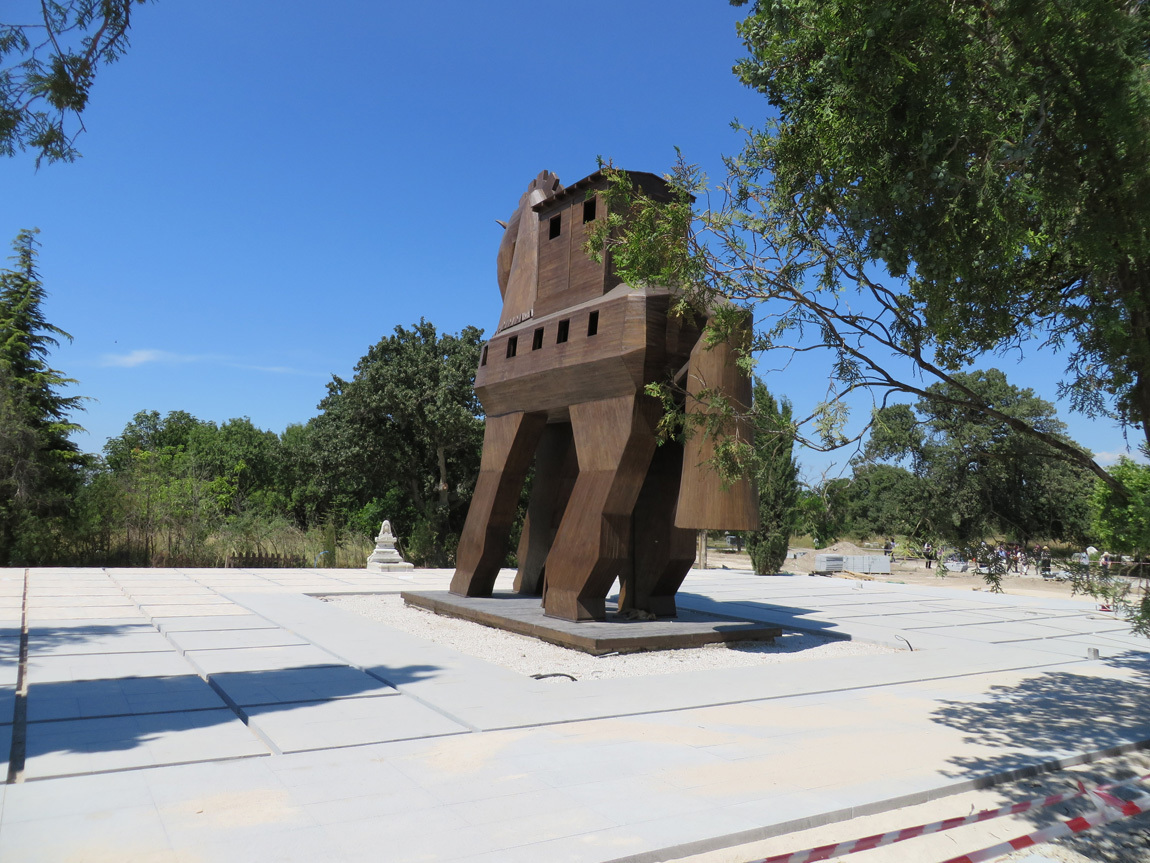
Near the entrance are piles of different relics, like this pot:
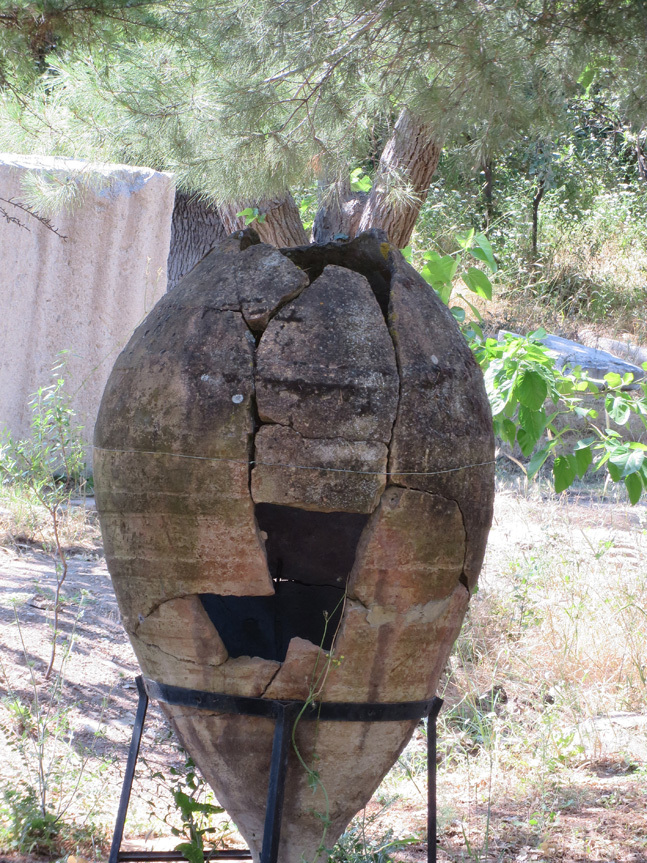
Here are some columns and parts of walls:
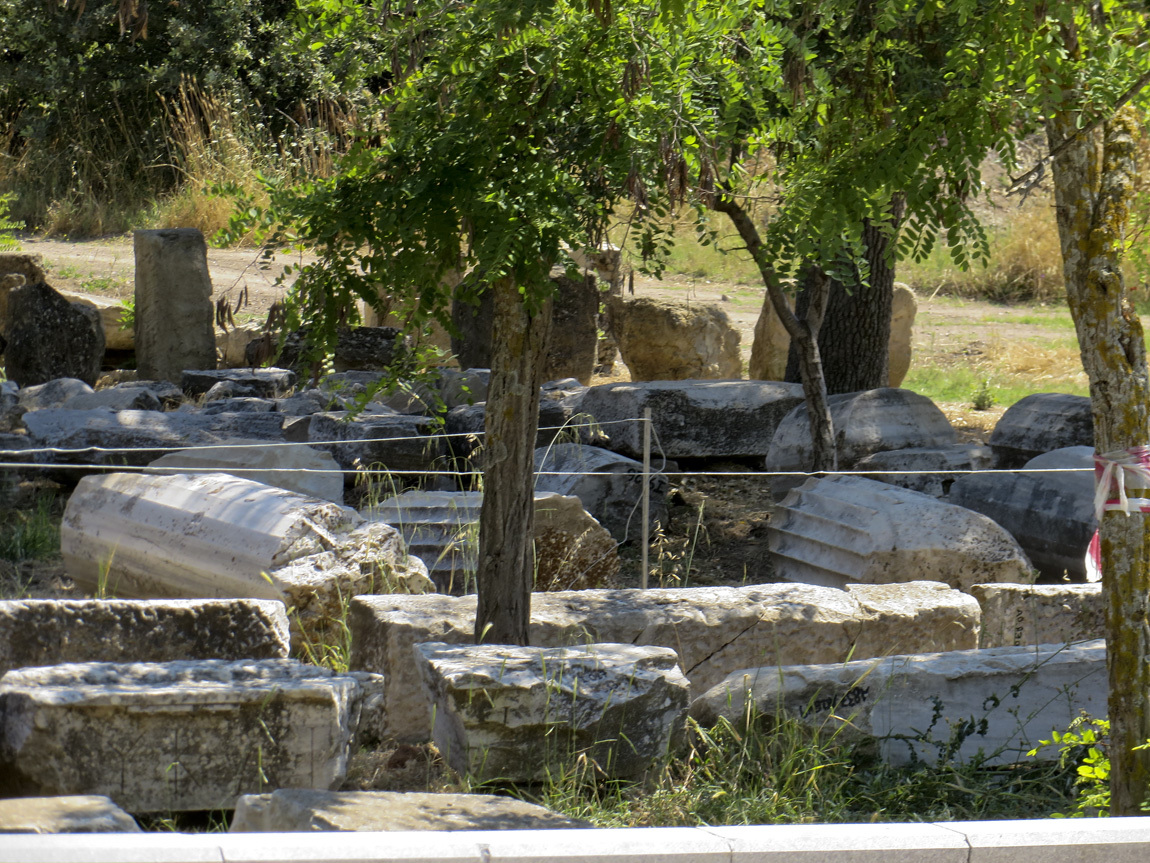
These pipes carried water in the ancient cities:
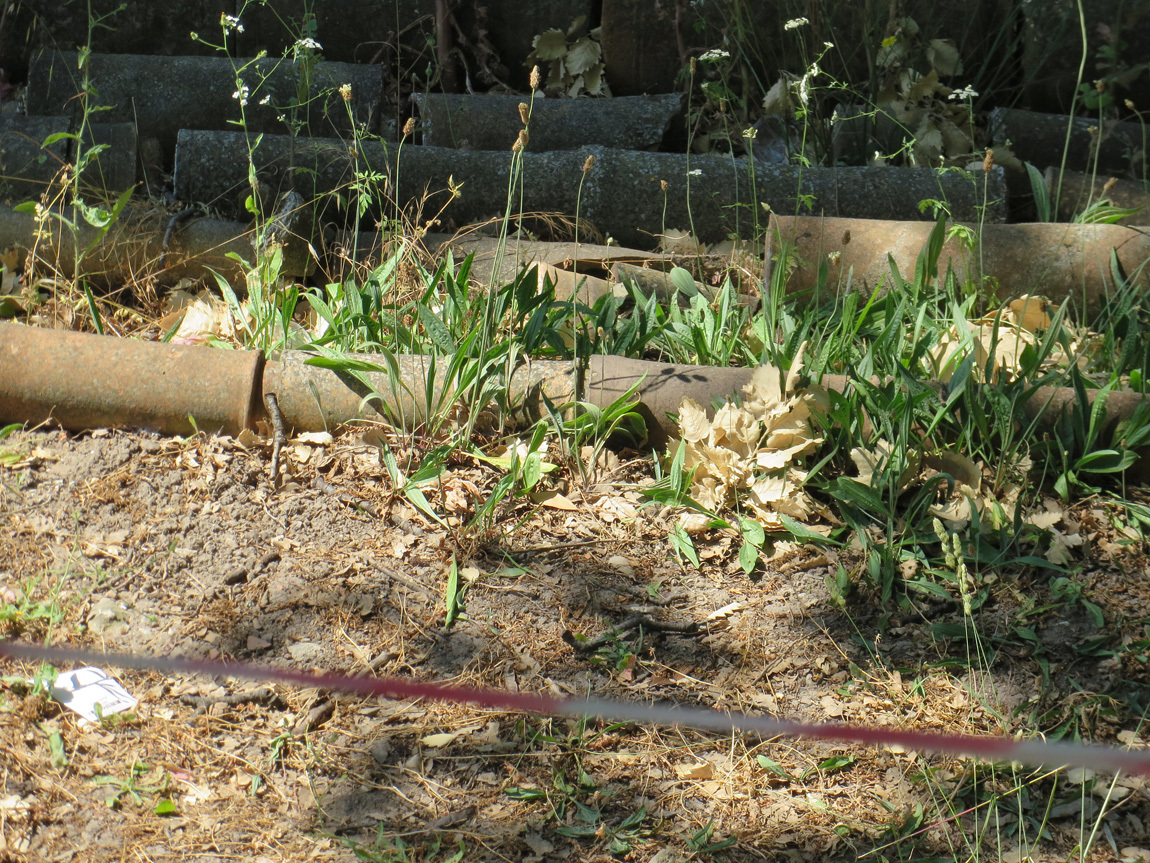
The path takes us towards ruins and a small hill. It's mindboggling to think that all that we are about to see was covered with earth until the late 1800s when the excavations began.
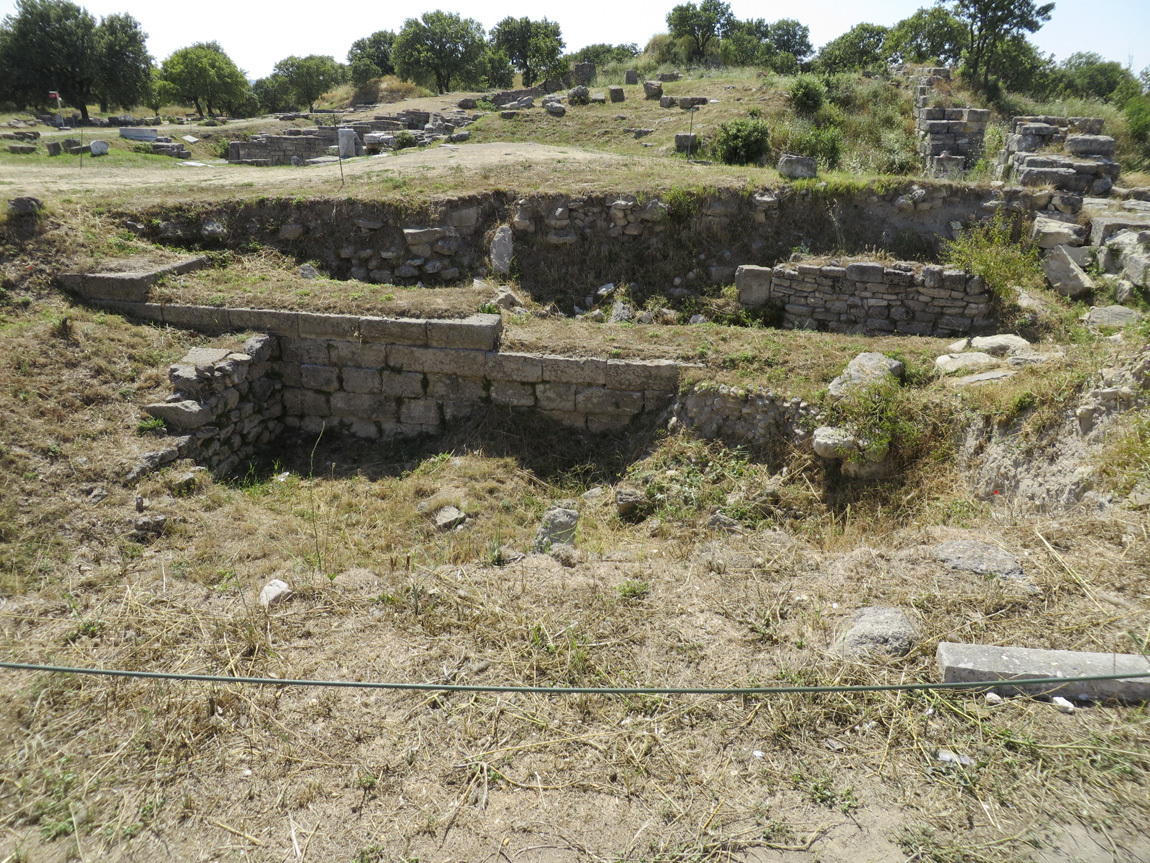
This sign signifies that the ruins of Troia (Troy) date from Ilios (1st century BC, Troy IX) to Wilusa (3000 BC, Troy I).
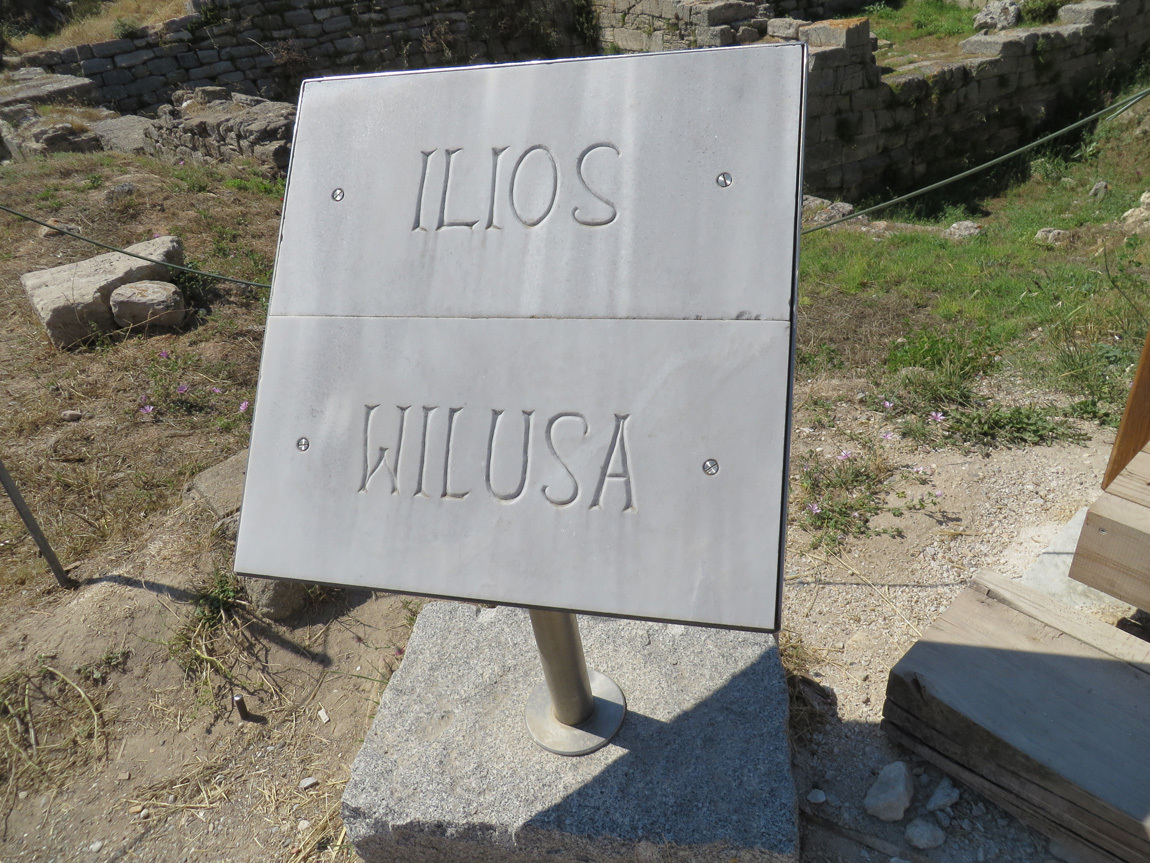
As we near the ruins, we see the remains of a structure. See that red umbrella in the right of the photo? That's where Ali is waiting for us. Our whisperers are on, and he will talk about the structures that we see.
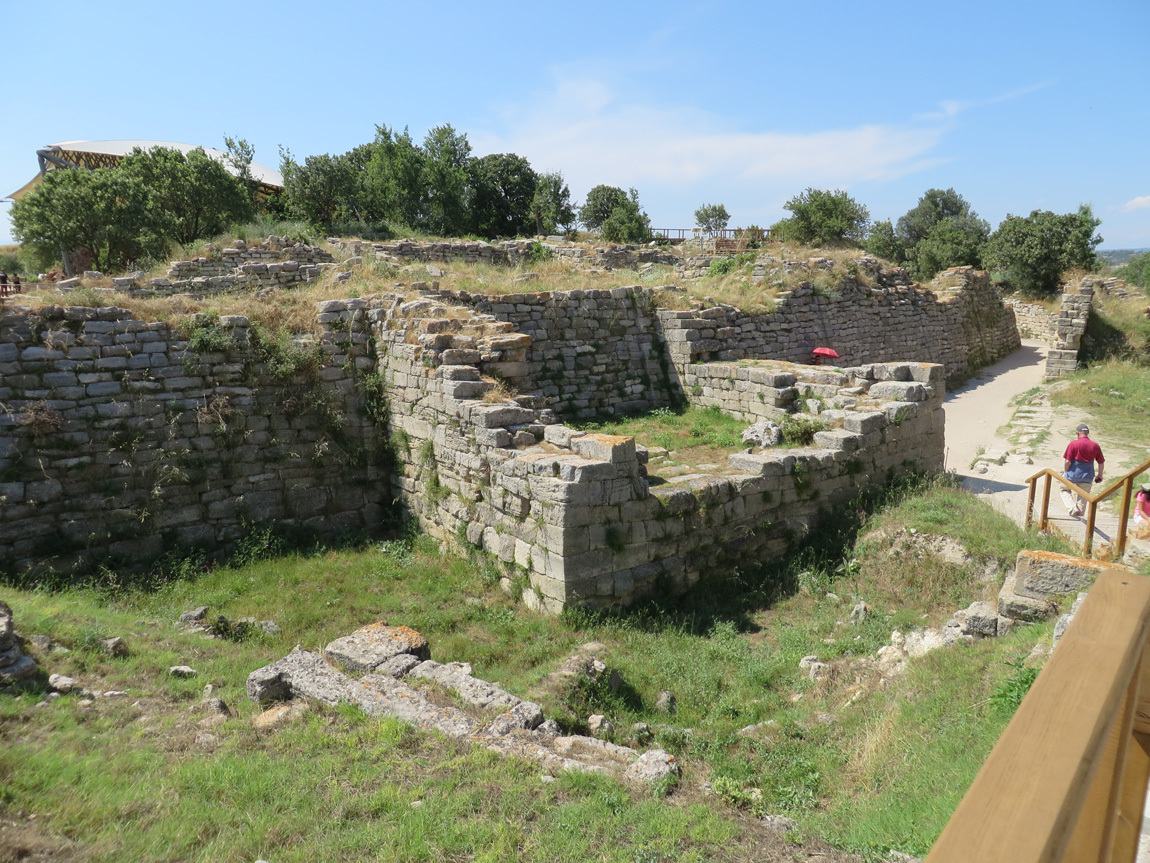
In the photo below, we have arrived at the spot where Ali is in the last photo. We see a narrow, curving passageway. In Homer's Troy, the narrow passageway made it easy to screen for foes and protect the city. As I walk through the narrow corridor, I think what it must have been like 3000 years ago. Were there armed guards on the walls? What sort of wonders are the wall guarding? What would I be wearing? Was it as hot then as it is now? (It's so dang hot that I wonder why anyone ever built a city here!)
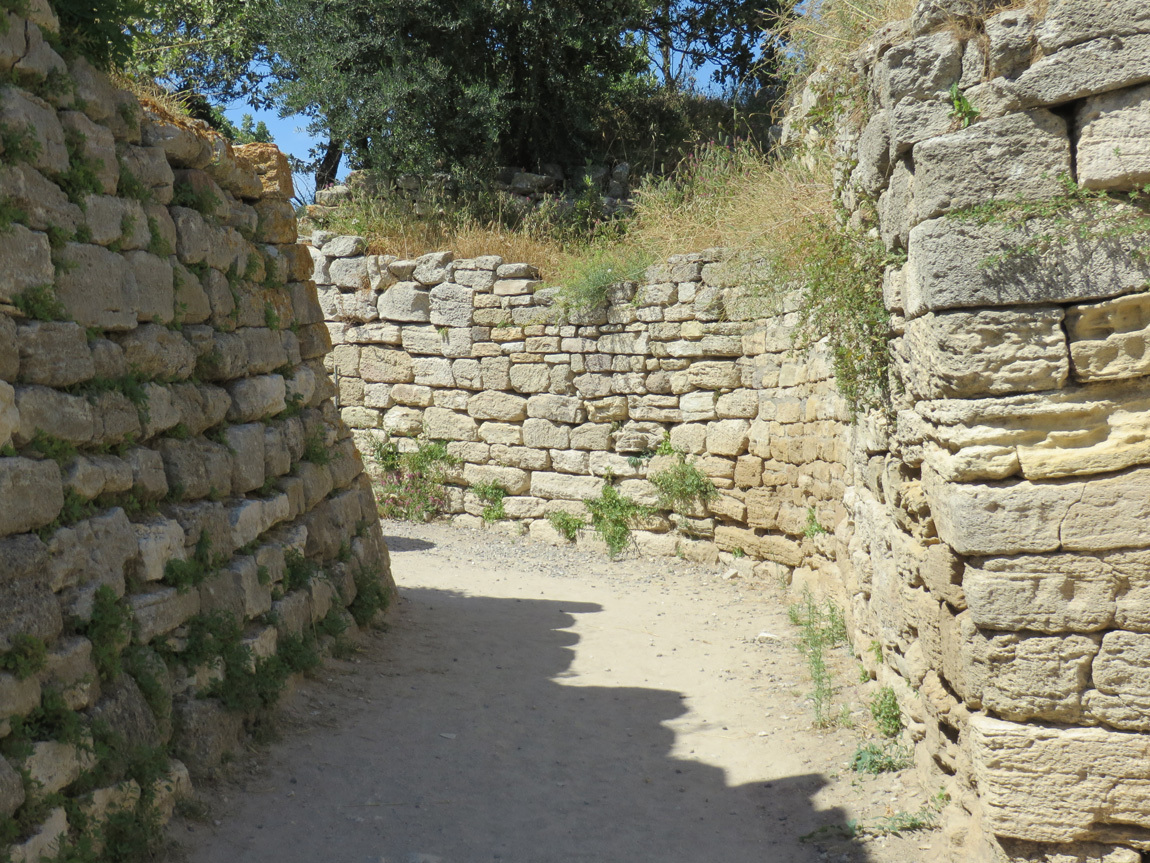
The inset in the wall is a stone culvert for water. There was once an artesian well system, constructed first in Troy VI and restored in Troy VII.
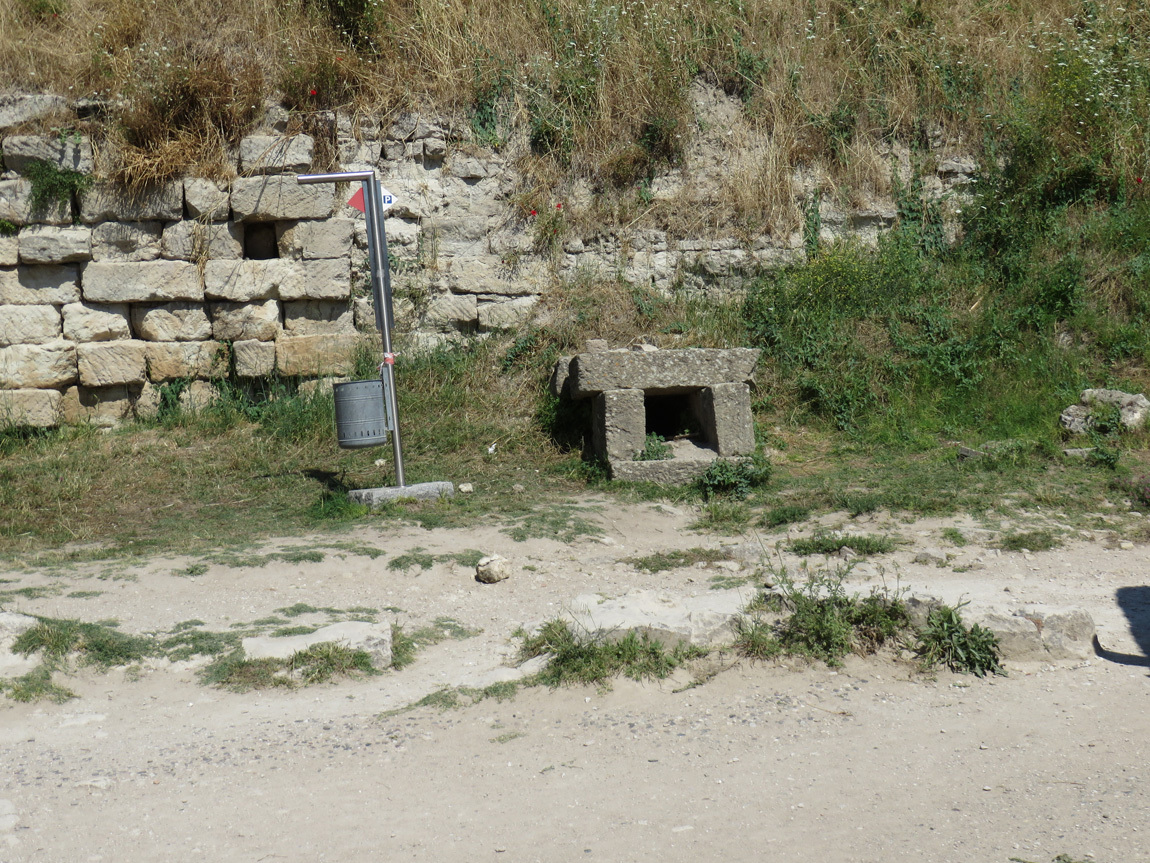
Further on, we see parts of walls from different times. We are now climbing up the small hill.
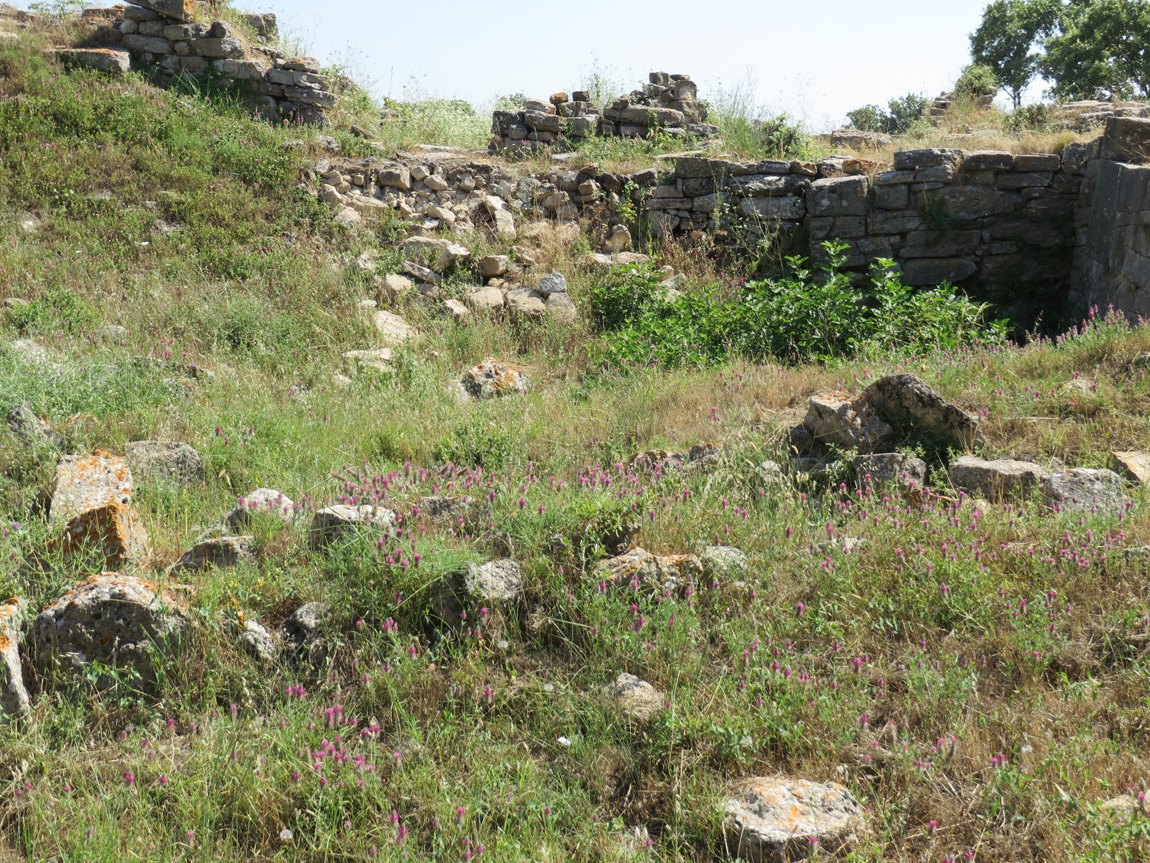
From the top of the hill, we can see out into a fertile Aegean plain, with a river running through it. Today, this Troy site is a few miles inland from the Aegean Sea, but at the time of Homeric Troy, the site was on the mouth of a river that formed a natural harbor on the Aegean, near the Dardanelles. Over the years, the mouth of the river filled in with silt, clay, sand and gravel, and is now a plain.
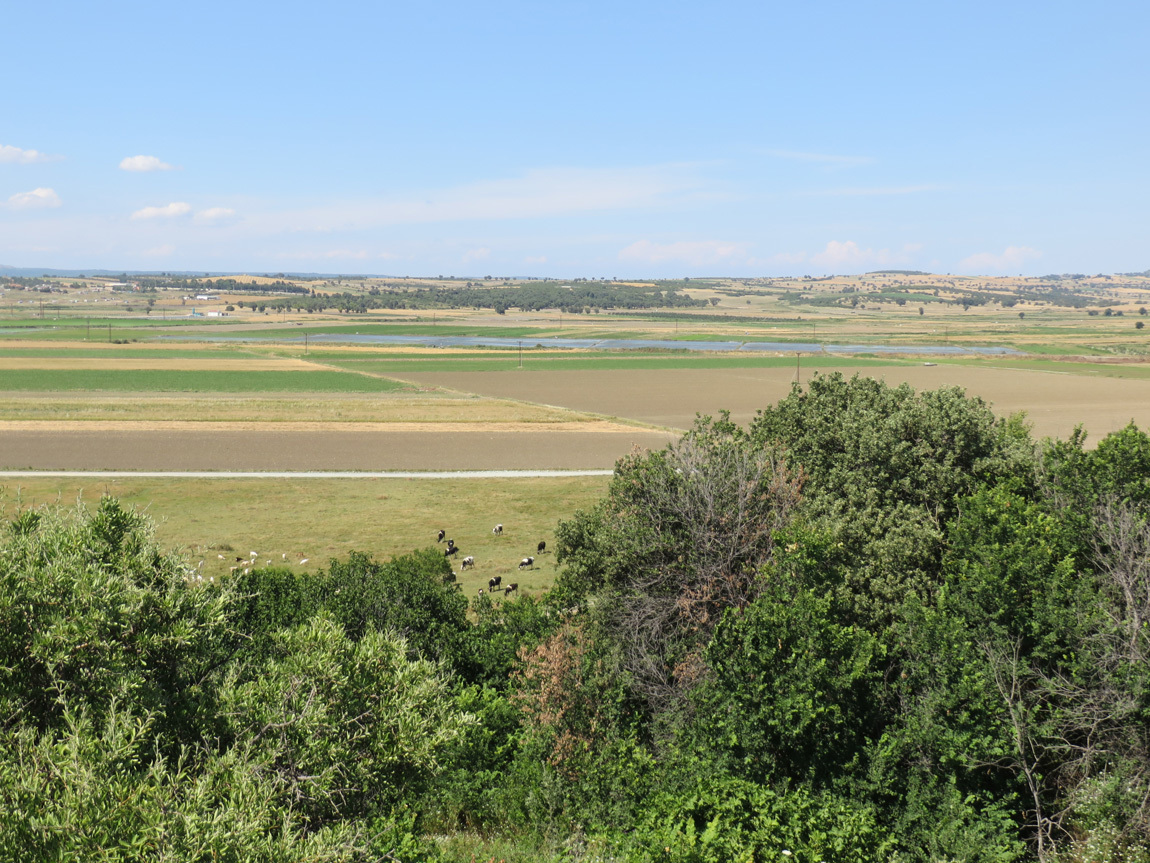
A sign says: "You are now standing on what remains of the foundations of an altar which belonged to the Greek and Roman temple of Athena. The remains of this temple had already been removed by stonerobbers when Schliemann began his excavation in 1871. Other limestone foundations were discovered at the same level. These derive from statues, altars and other small architectural features in the courtyard of the temple precinct, and some of their marble fittings have been found."
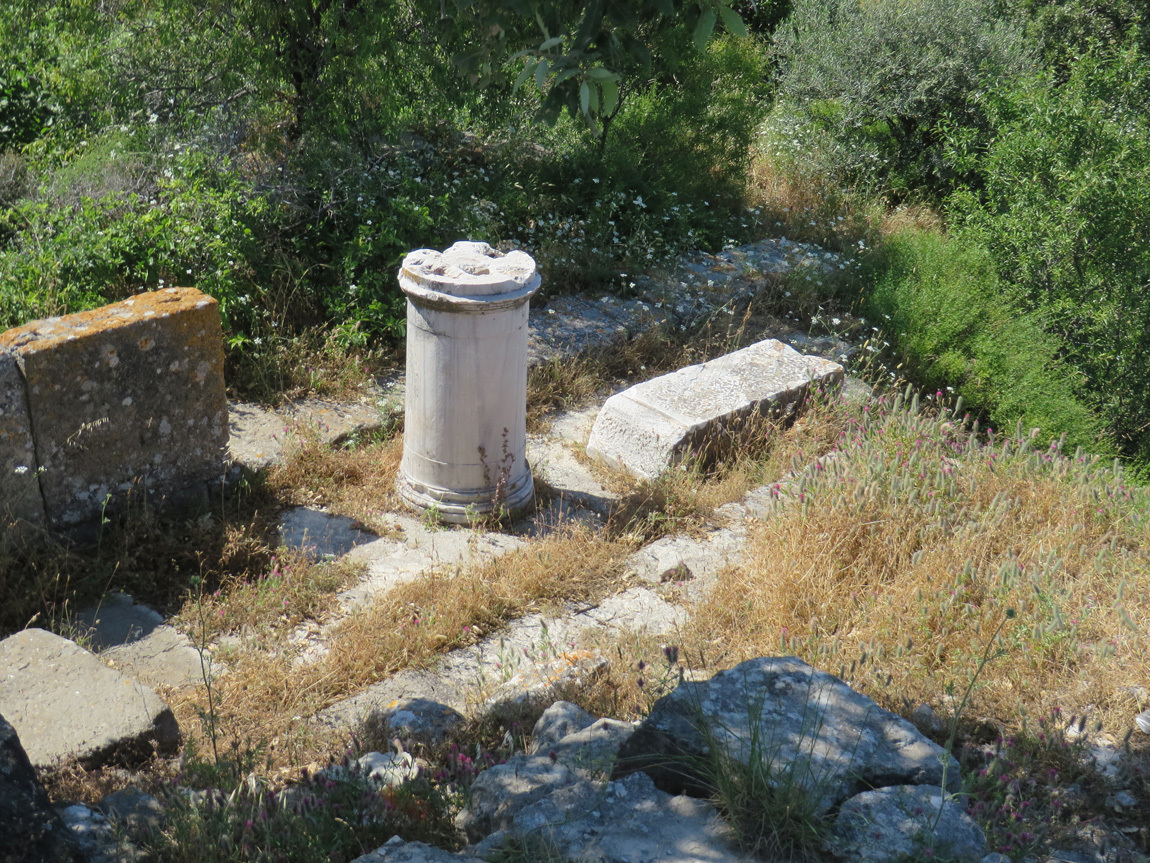
A sign says: "Where you are now standing there once lay the forecourt of the temple of Athena belonging to the Greek and Roman city of Ilion (Troy I). Looking down you can see in the center of the mound a wide area at a lower level. This was excavated by Schliemann and Dorpfeld. The marble architectural fragments lying there originally belonged to the temple of Athena. The temple, whose base measured 36m x 16m, was surrounded by a Doric colonnade supporting a coffered ceiling. Outside, on the entablature, were metopes (reliefs) the most famous of which shows Apollo/Helios. This is now displayed in Berlin."
Berlin! They took the artifacts from the Ottomans and put them in a German museum. The Turks are still negotiating to get them back.
The sign continues: "It is thought that the temple was built by Lysimachus, one of Alexander the Great's successors, around 300 BC. In Greek and Roman times the temple was the focal point of a great annual festival in honor of the goddess Athena. This festival was marked by sacrifices and athletic contests."
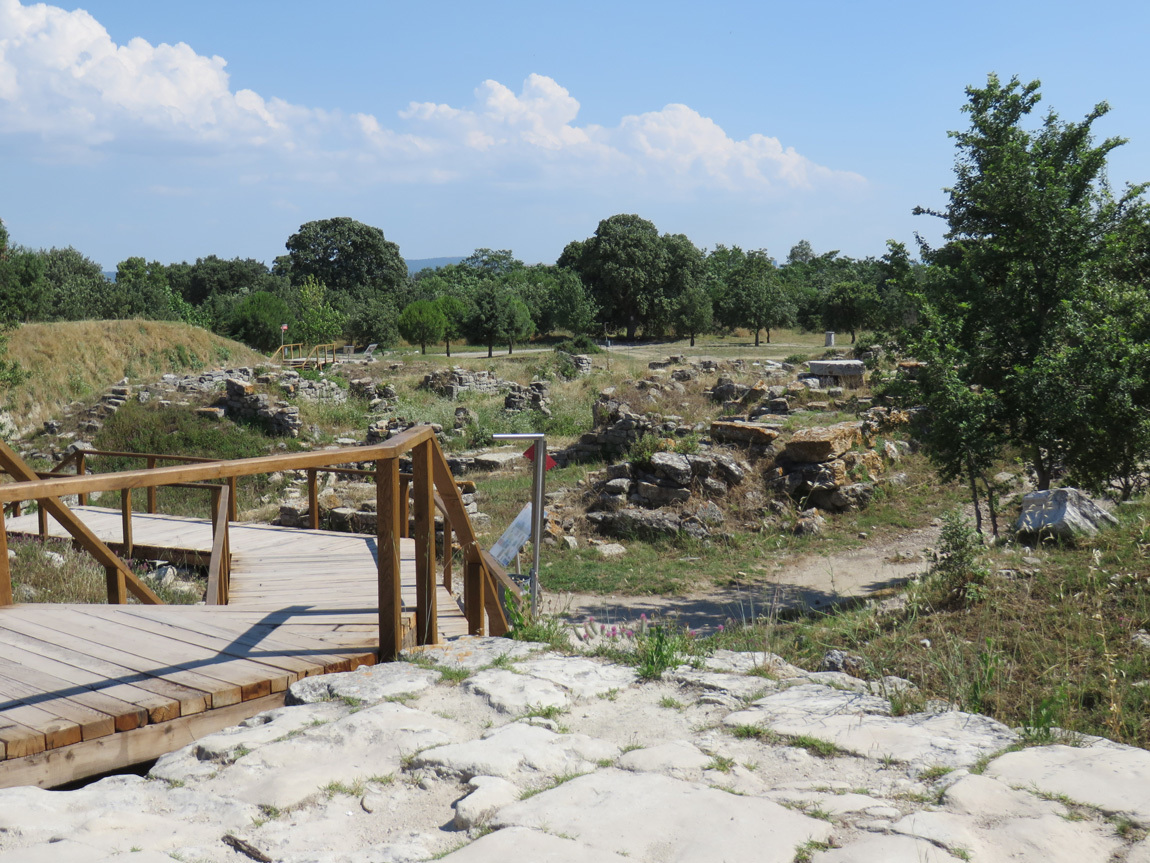
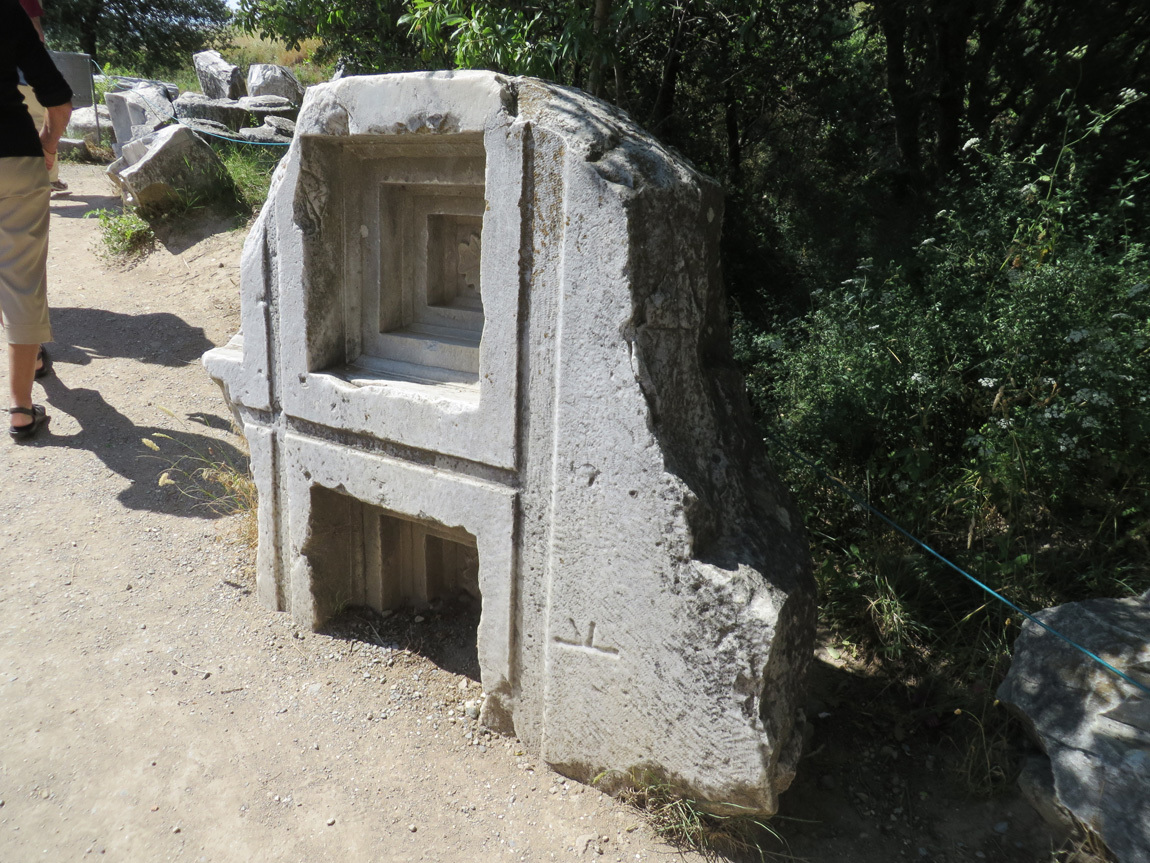
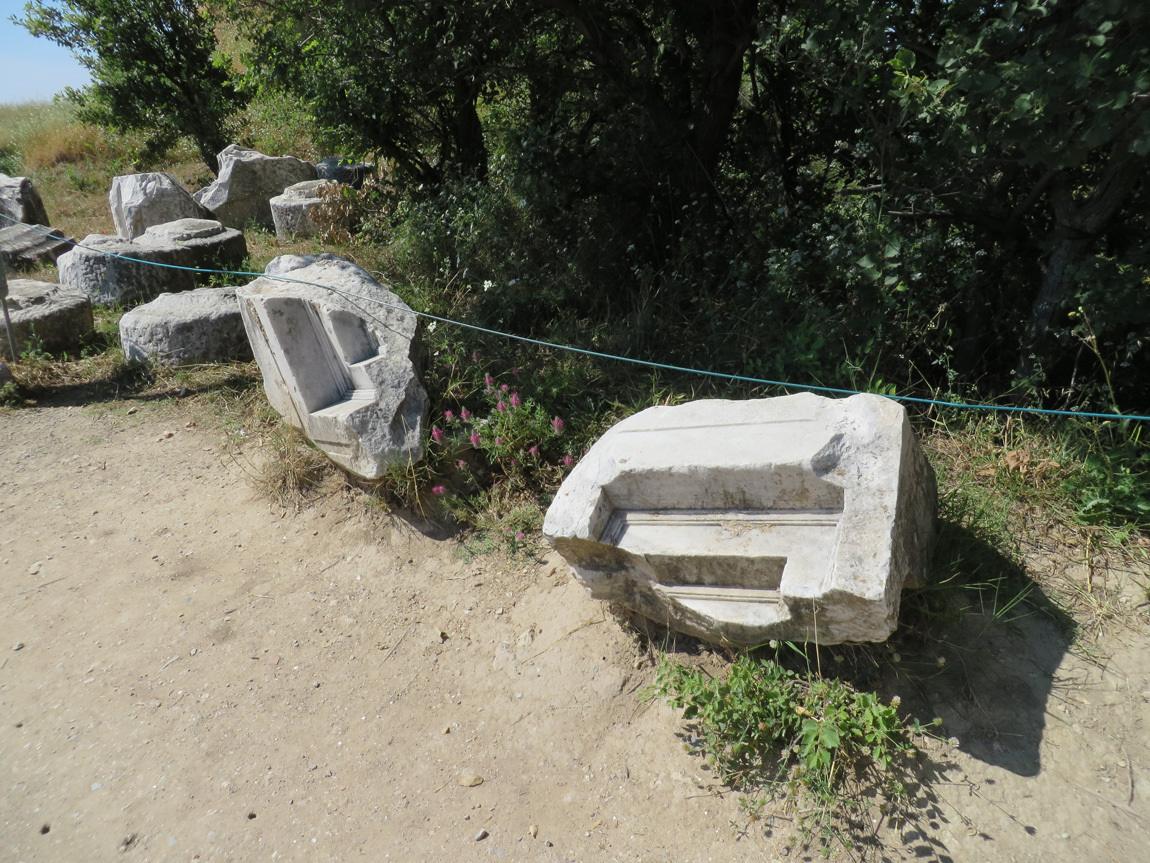
The sign in this photo says "original foundation stones belonging to the fortification wall and towers of Troia II, III (c 2500 BC)".
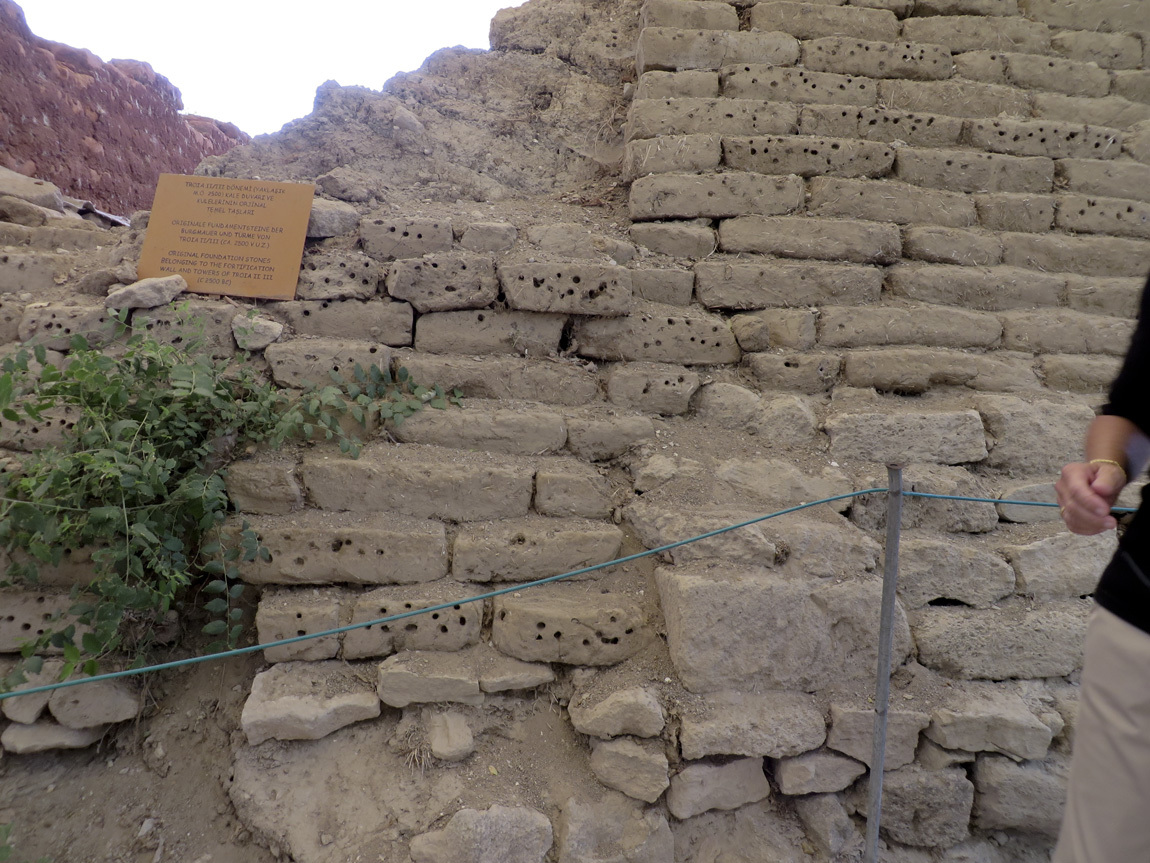
This is the view of the outside of the Troia II/III Citadel Wall, ca 2500-2200 BCE (Schliemann's "Burnt City"). This is a reconstruction built with hand-made and fired mudbrick. The reconstruction conceals and protects the original mudbrick material. A fire gave the original brick of the upper and outer part of the wall a red color.
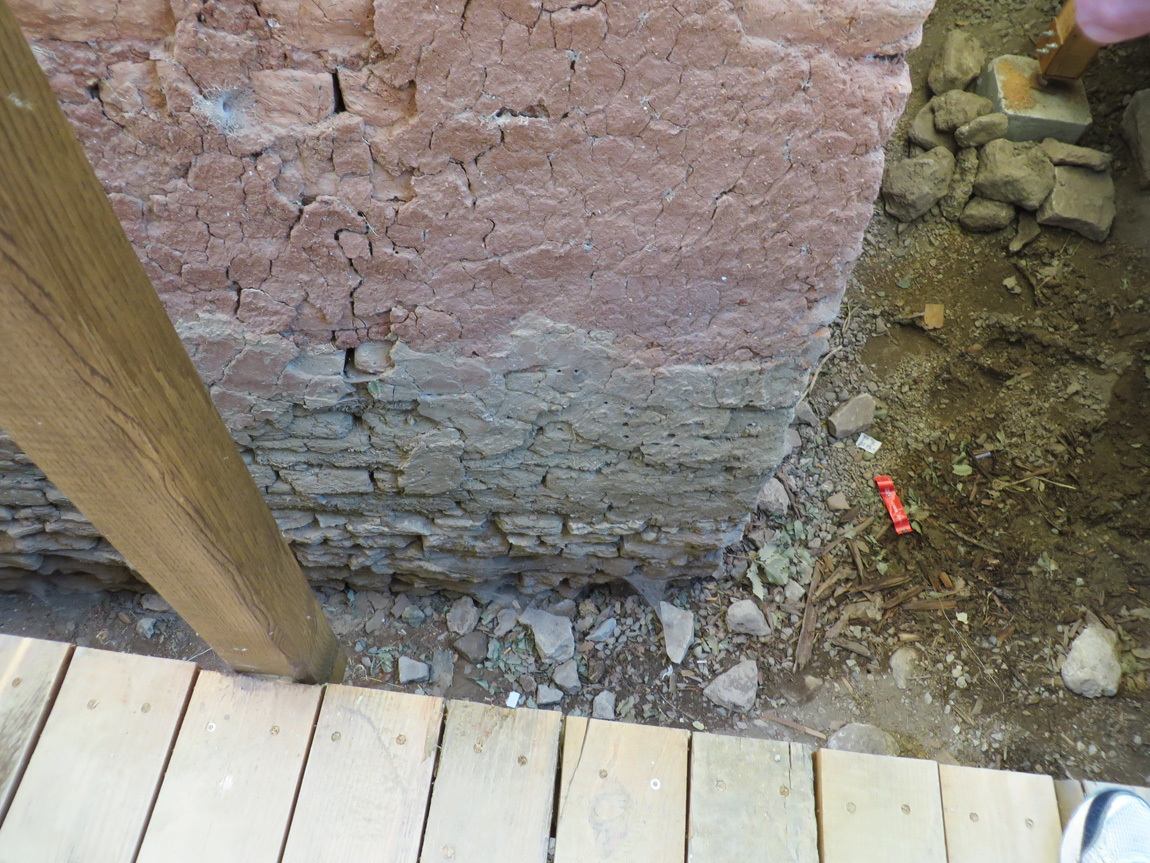
Inside the Citadel is a mudbrick building with a stone foundation excavated in 1998/99. This building was found with its walls still standing up to a height of over 1.5 meter. In 2003, a roof was built over the mudbrick building so that it could be opened to the public without the archaeological material being harmed.
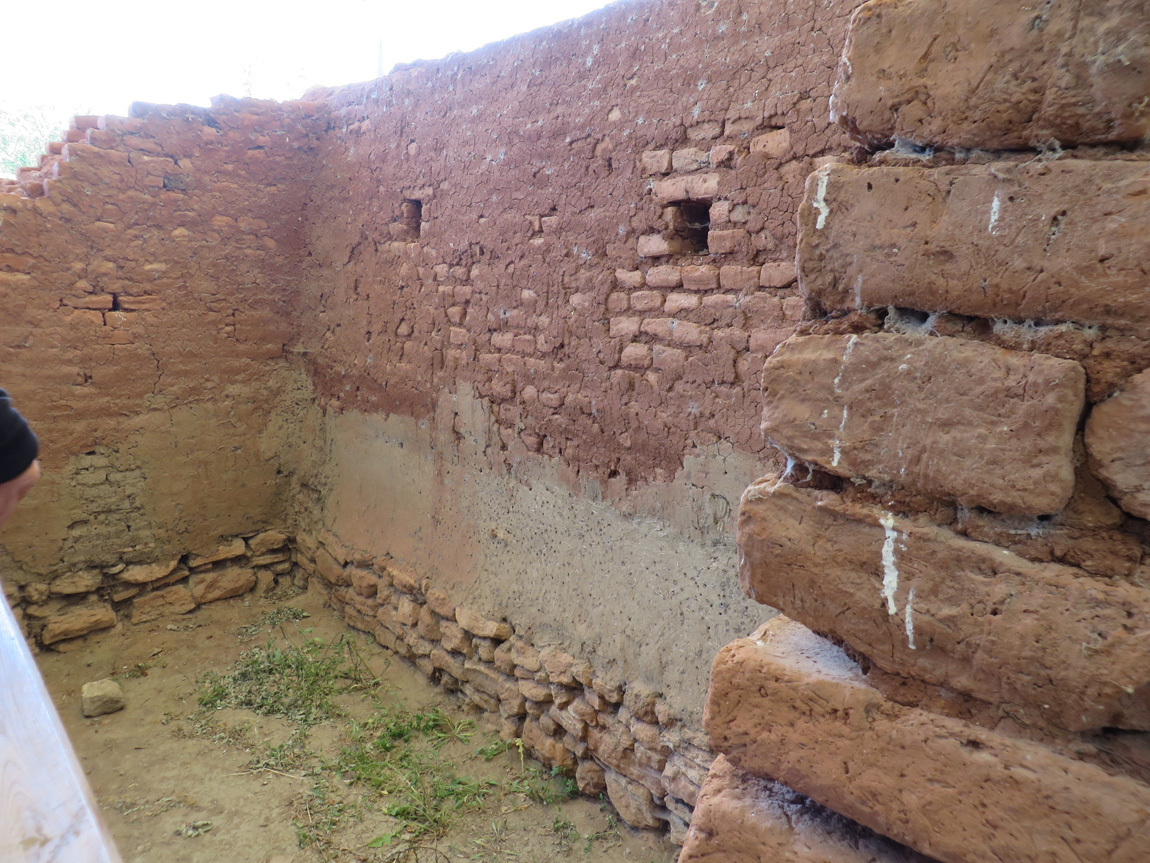
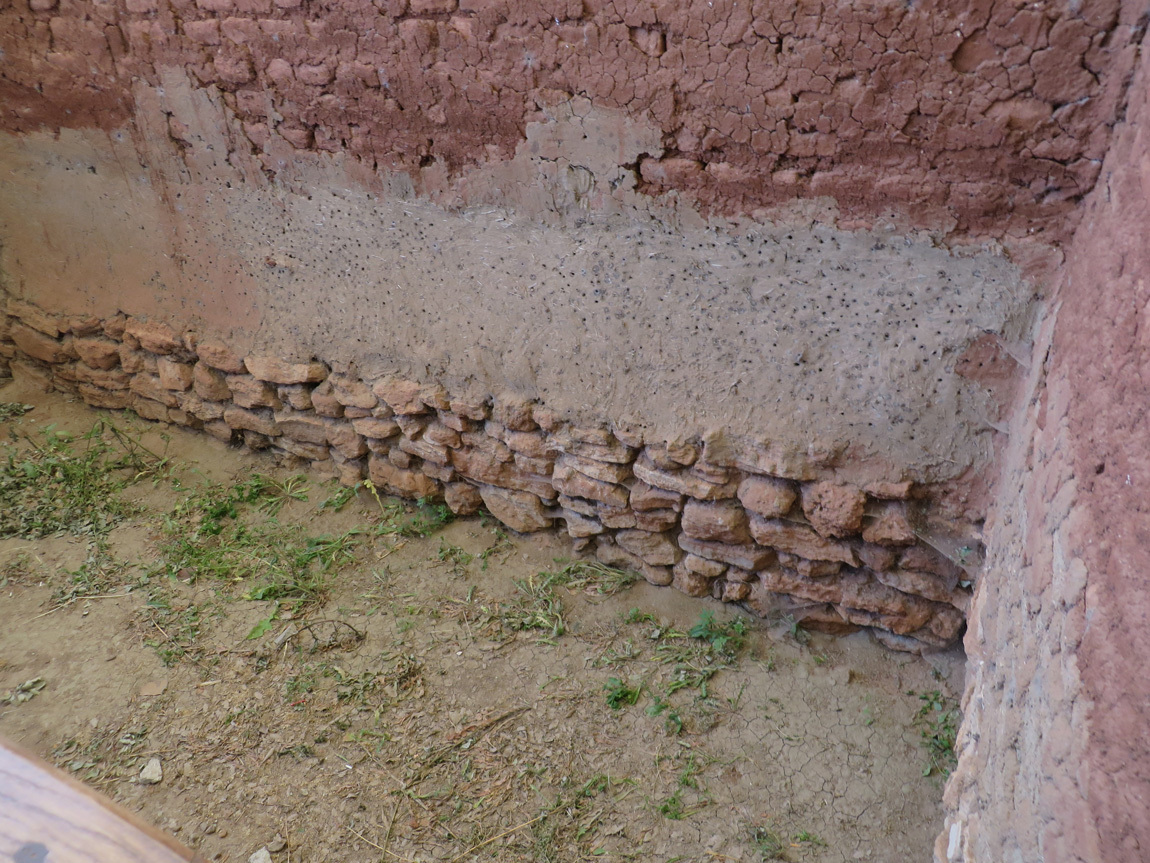
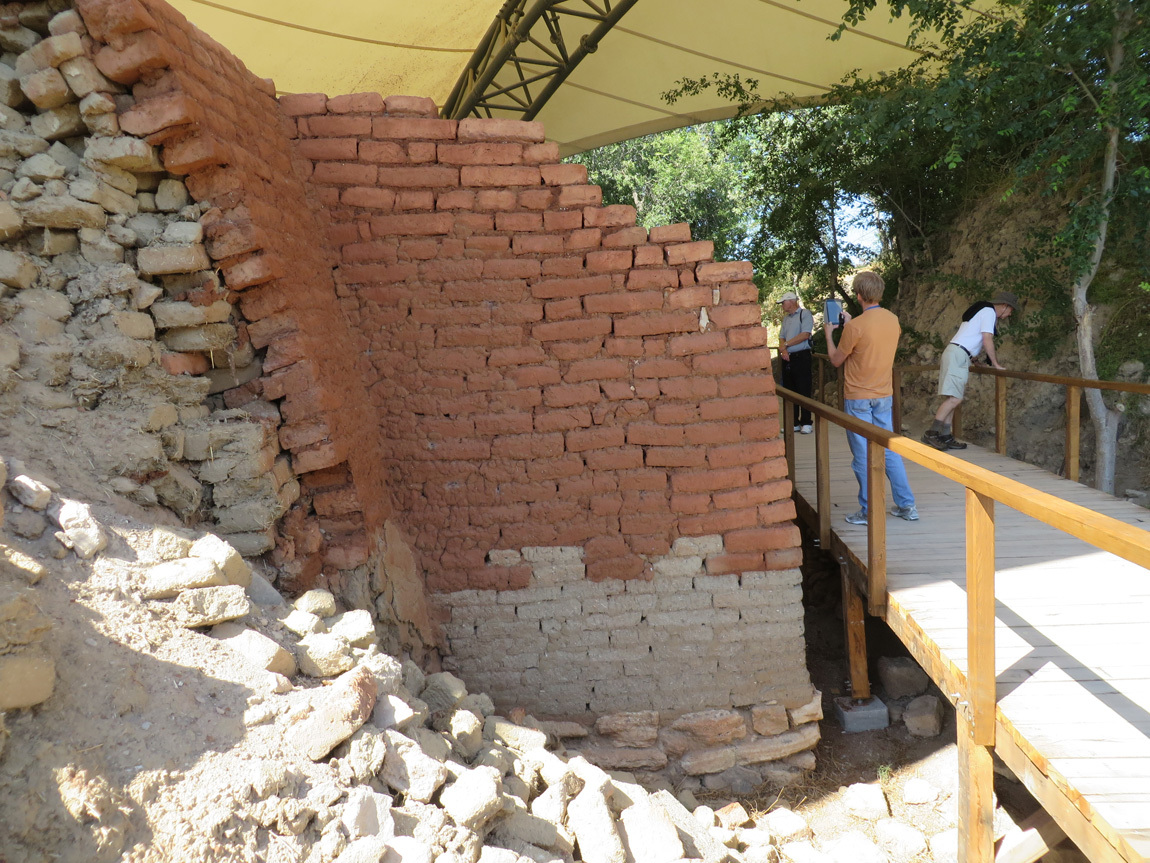
The photo below shows part of the fortifications of Troia I. Troia I was built c 2920 BCE directly on bedrock. Archaeological deposits four meters deep suggest a long period of occupation. The slightly inward-sloping fortification wall enclosed a settlement with a diameter of about ninety meters. In front of the tower stood at least one stone slab or stele with relief decoration showing the upper half of a human figure possibly holding a weapon.
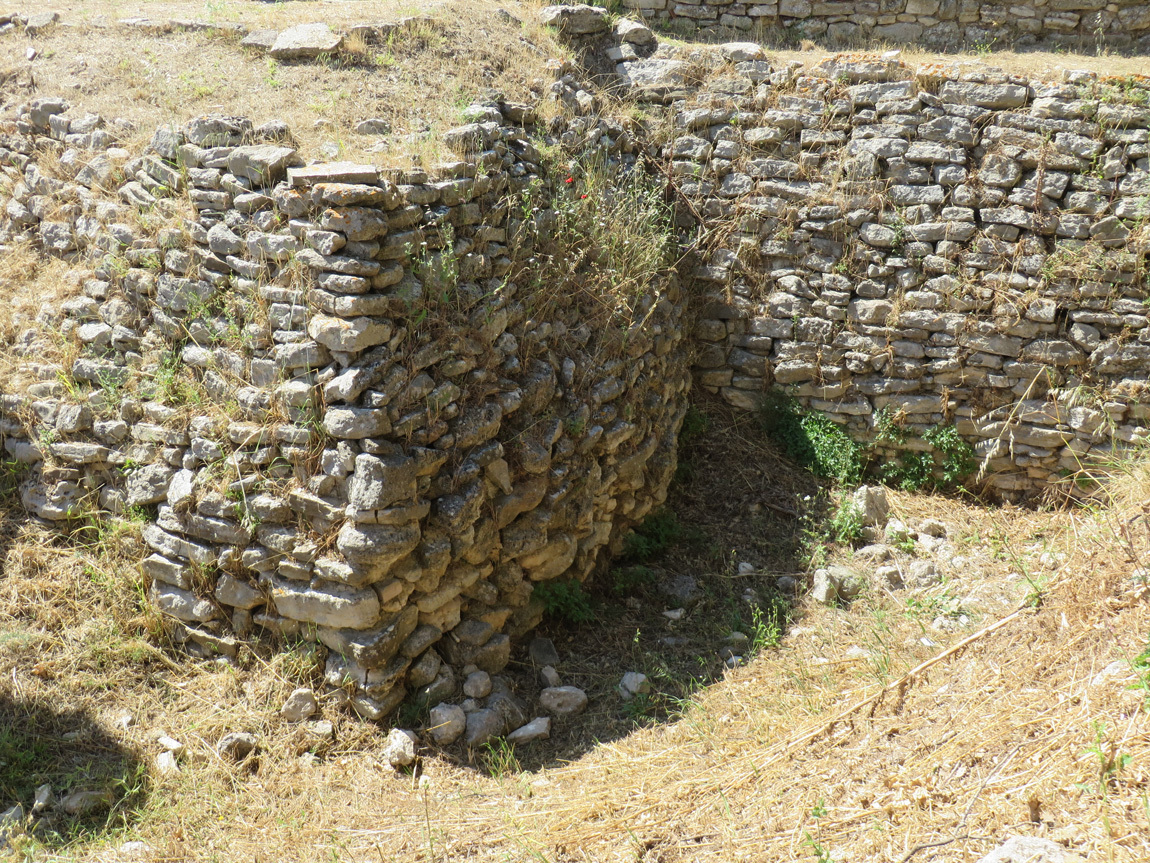
Schliemann made a deep trench, forty meters wide and seventeen meters deep, through the center of a mound. Schliemann was looking for the treasure of "Priamâ€s Citadel". He destroyed remains of buildings from the overlying layers while digging this trench. At the bottom of the trench Schliemann found remains of walls belonging to the early Troia I period (c 2920 BCE). You can see these in front in the photo below. It was only in the American excavations of the 1930s and in the work carried out since 1988 that the Troia I period was more closely studied. The rows of parallel, rough stone walls are the foundations of relatively large, close-set houses.
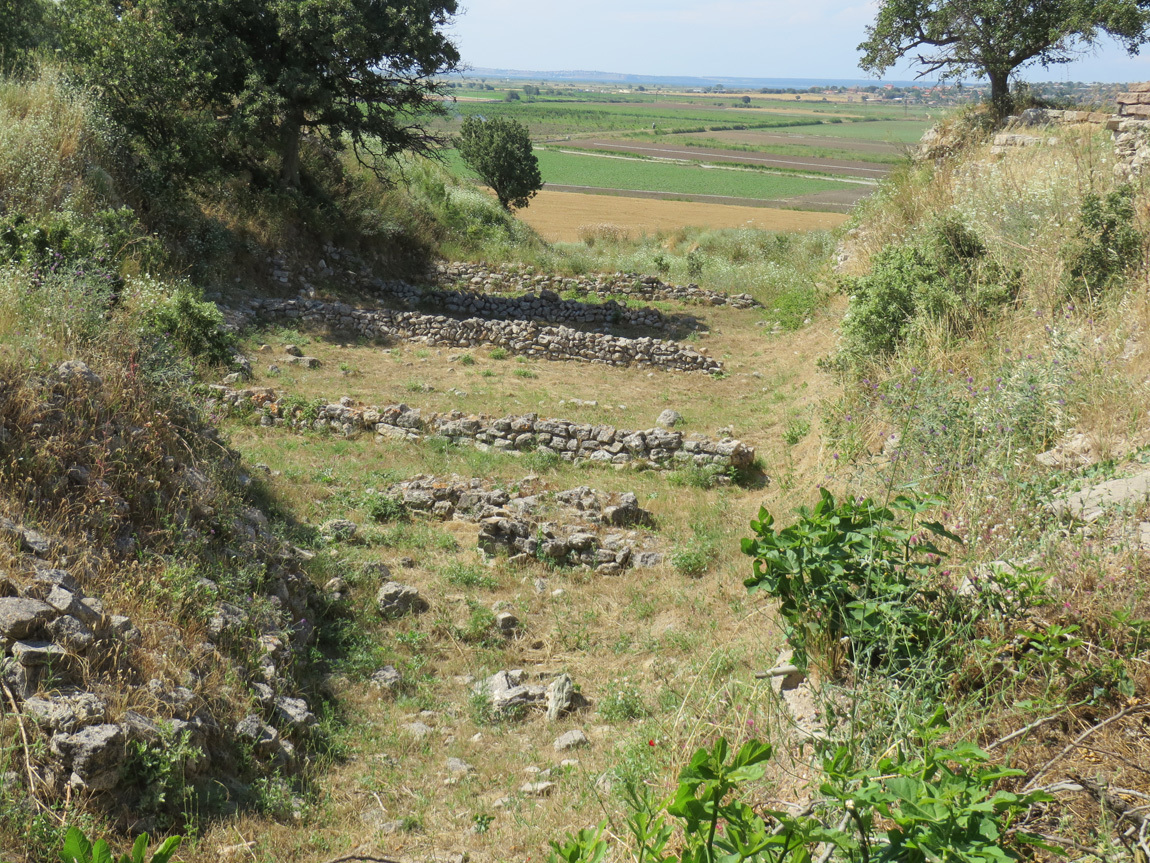
Schliemann was kind of a rat. During the excavation of Troy, he came across a remarkable copper article behind which he saw gold artifacts. He called a lunch break so the workers would leave the area. He proceeded to secretly take the treasure and smuggle it out of Anatolia. This treasure is known as "Priam's Treasure', because Schliemann believed it was from a king during Troy VI or VII. Most likely though, it was from Troy II because of the level at which it was found. He was found out when his wife wore some of the jewels in public in Germany. Today, some of this treasure is in Berlin, some in Moscow, and some in Istanbul.
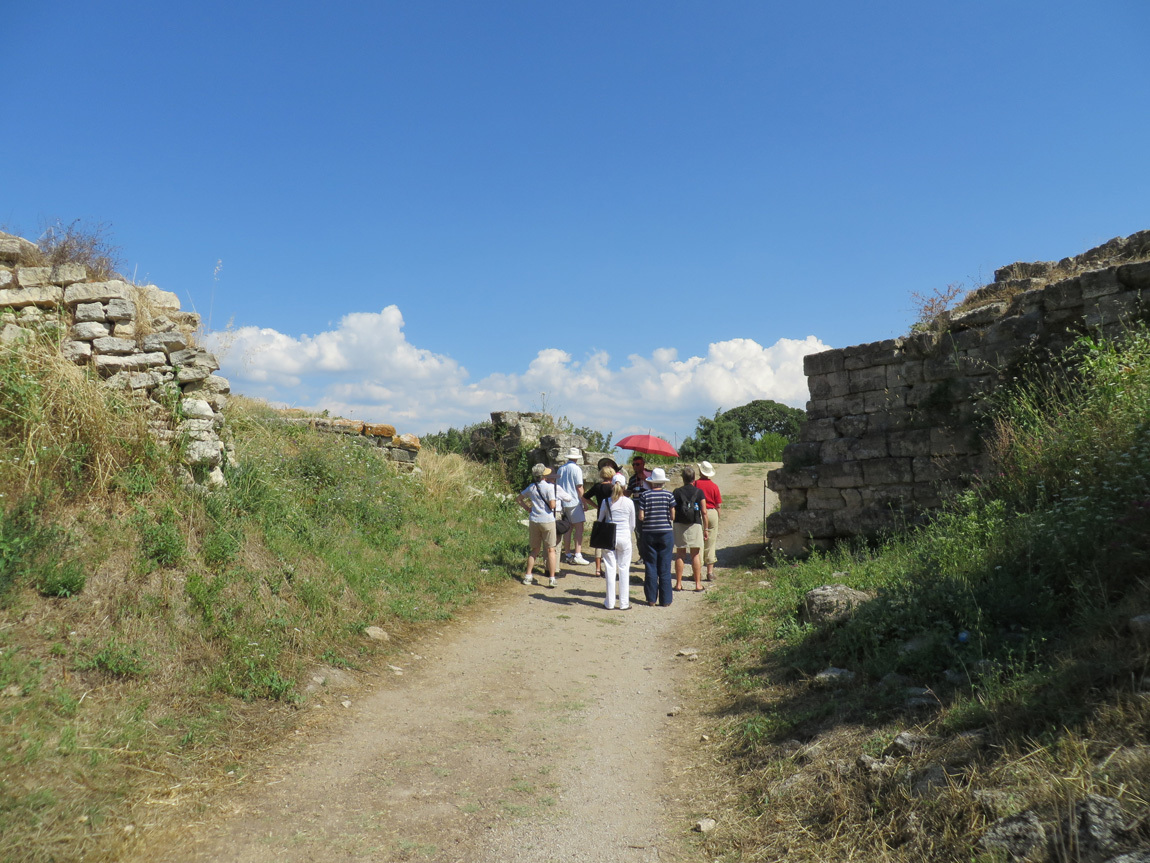
The photos below are of the south gate of Troia VI, probably the principal entrance to the citadel. Only the roadway to the gate survives today. It led in a straight line up into the citadel and was entirely paved with stone slabs. In the middle of the road was a drainage channel that ran beneath the paving stones. You can also see remnants of the South Tower of Troia VI. The walls are built directly on bedrock and two meters of them are preserved. Stone stelae (decorated slabs) stood in front of the tower. There are also remnants of a house called the Pillar House. (Note: Troy VI was before Troy VII, around 1700-1250 BCE.)
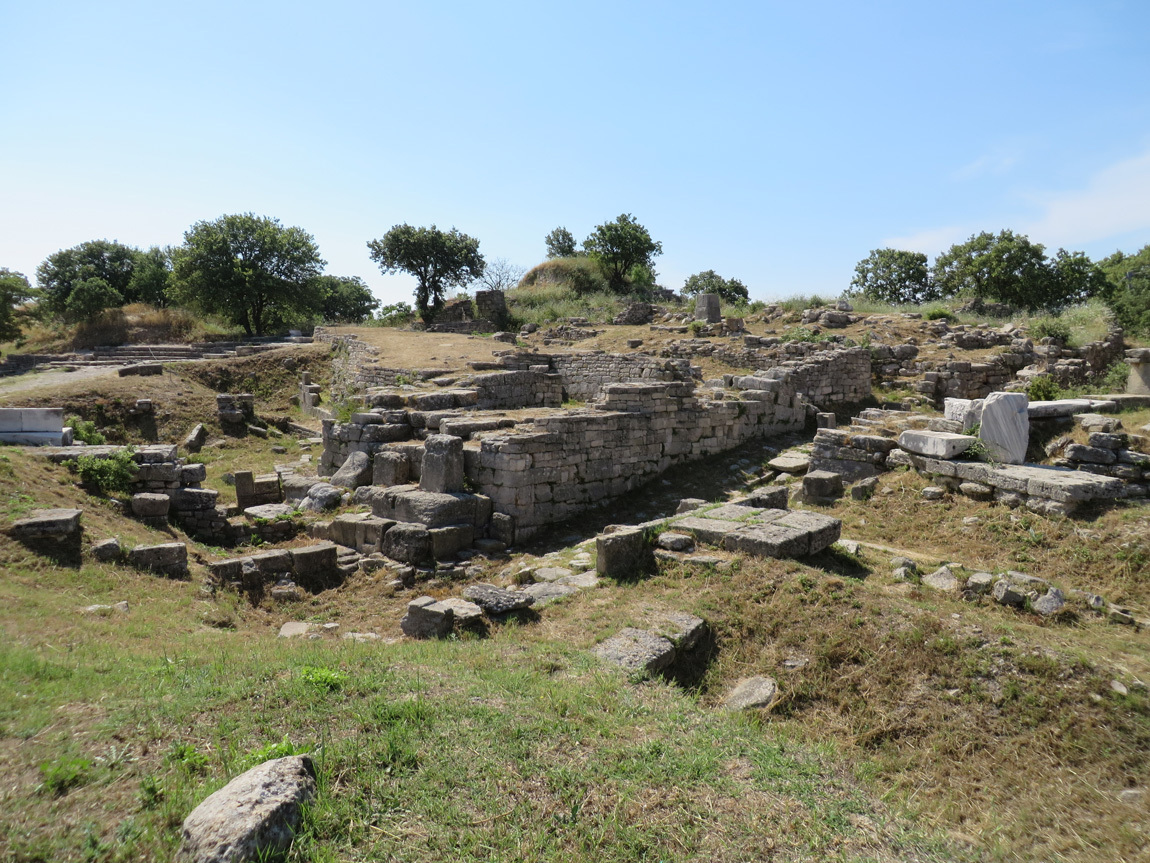
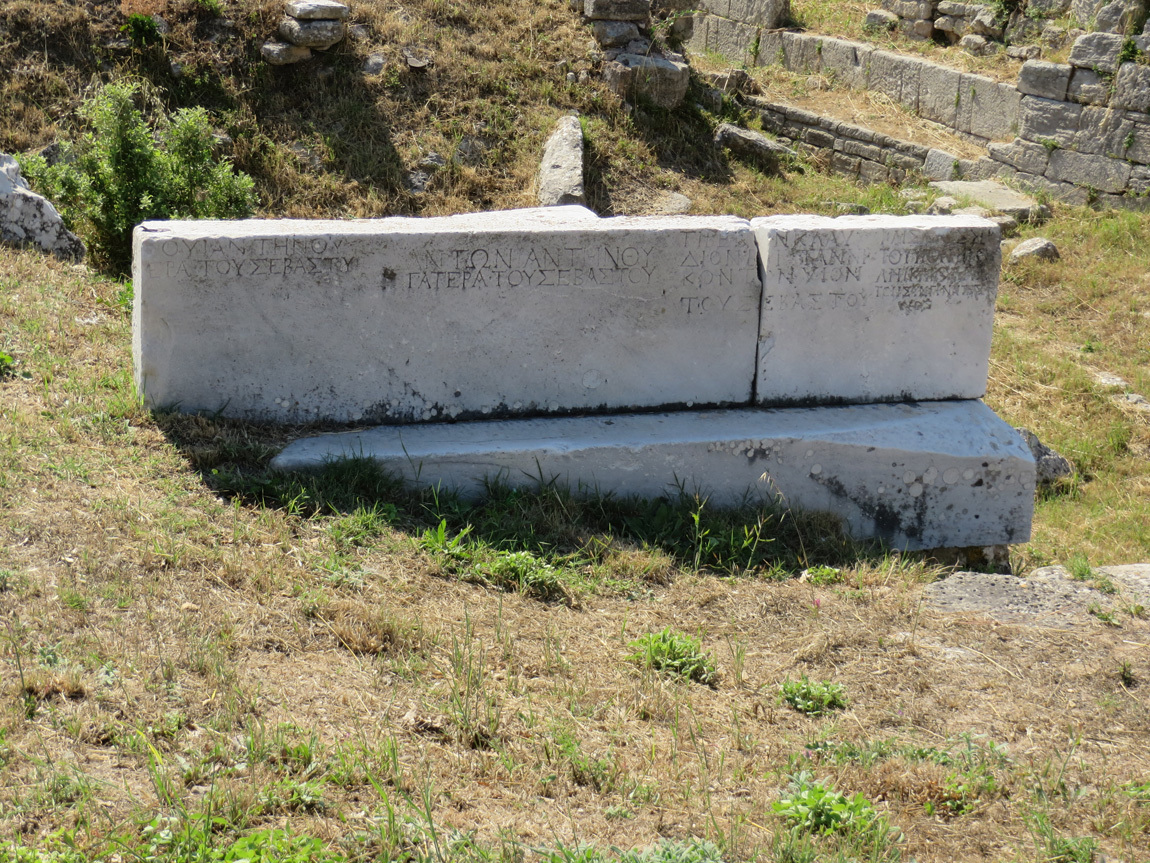
Below are photos of a Roman Odeion (similar to an ampitheater), intended for the presentation of musical performances. The Odeion has a semi-circular orchestra, with a skene (stage-building) in which stood an over-lifesize statue of the Emperor Hadrian (117-138 AD). The orchestra is bordered by a wall of limestone slabs above which rise tiers of seats constructed of large limestone blocks. Visible behind the Odeion are the Troia VI walls and Pillar House.
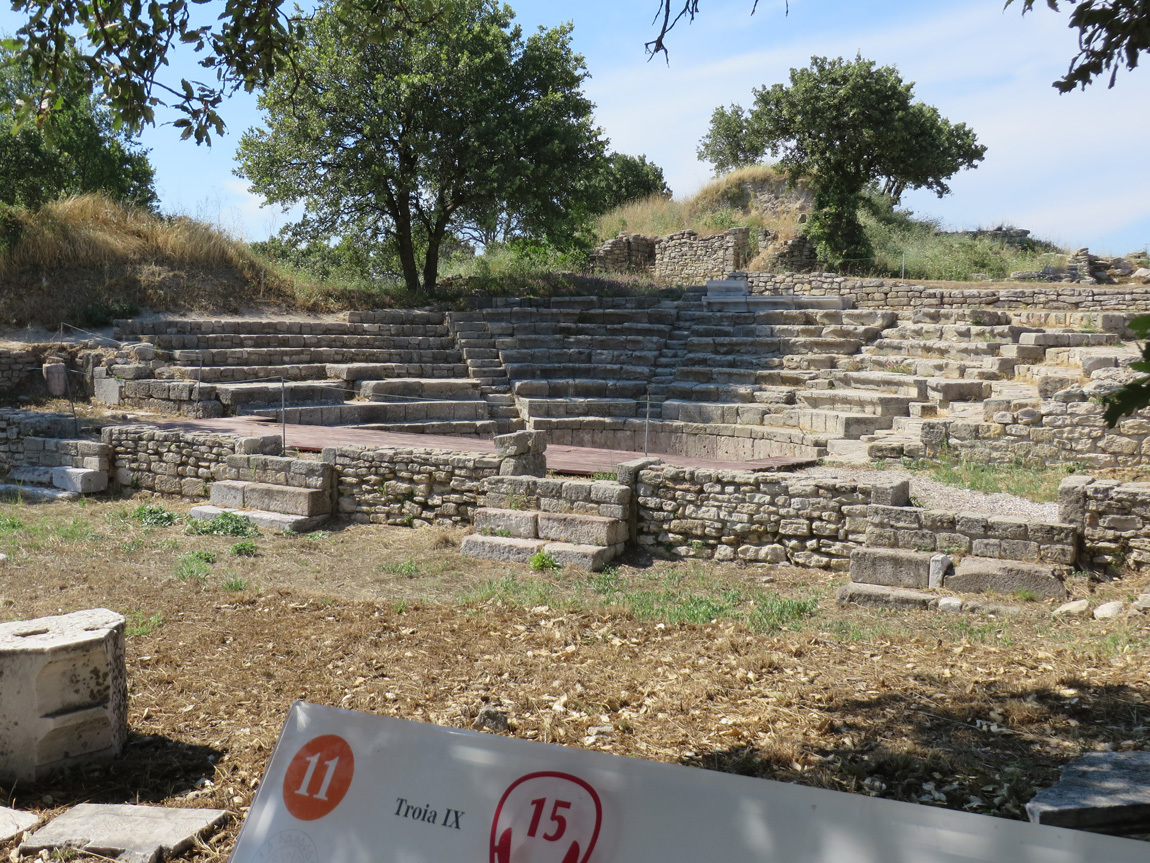
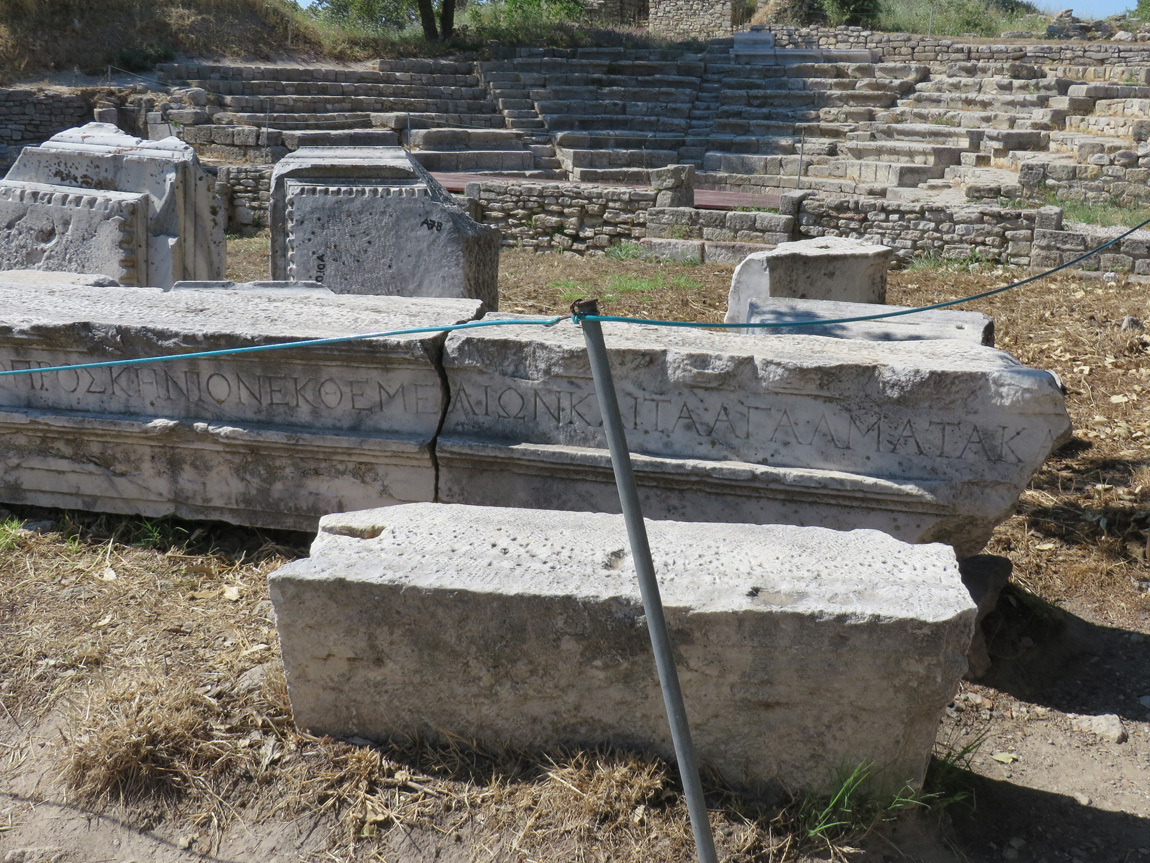
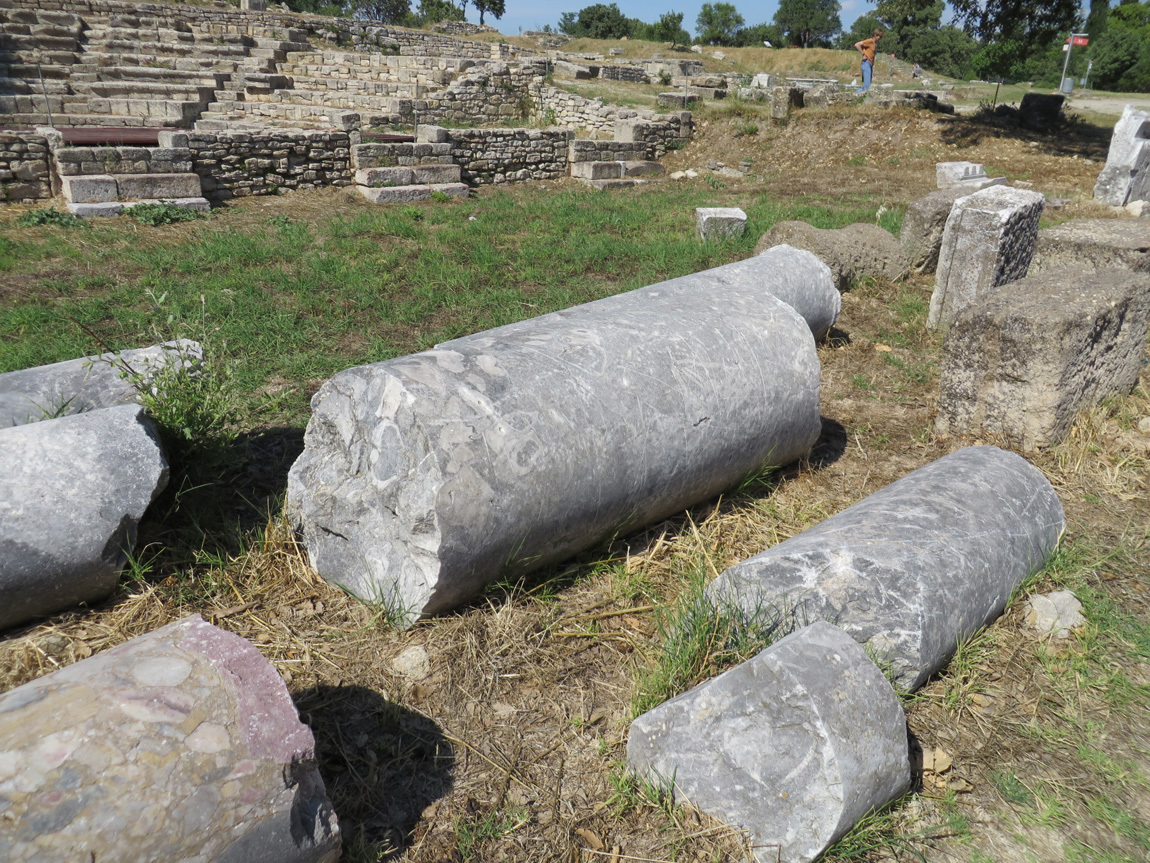
Next to the Odeion were bath houses and an agora (market place), where the public life of the city was focused.
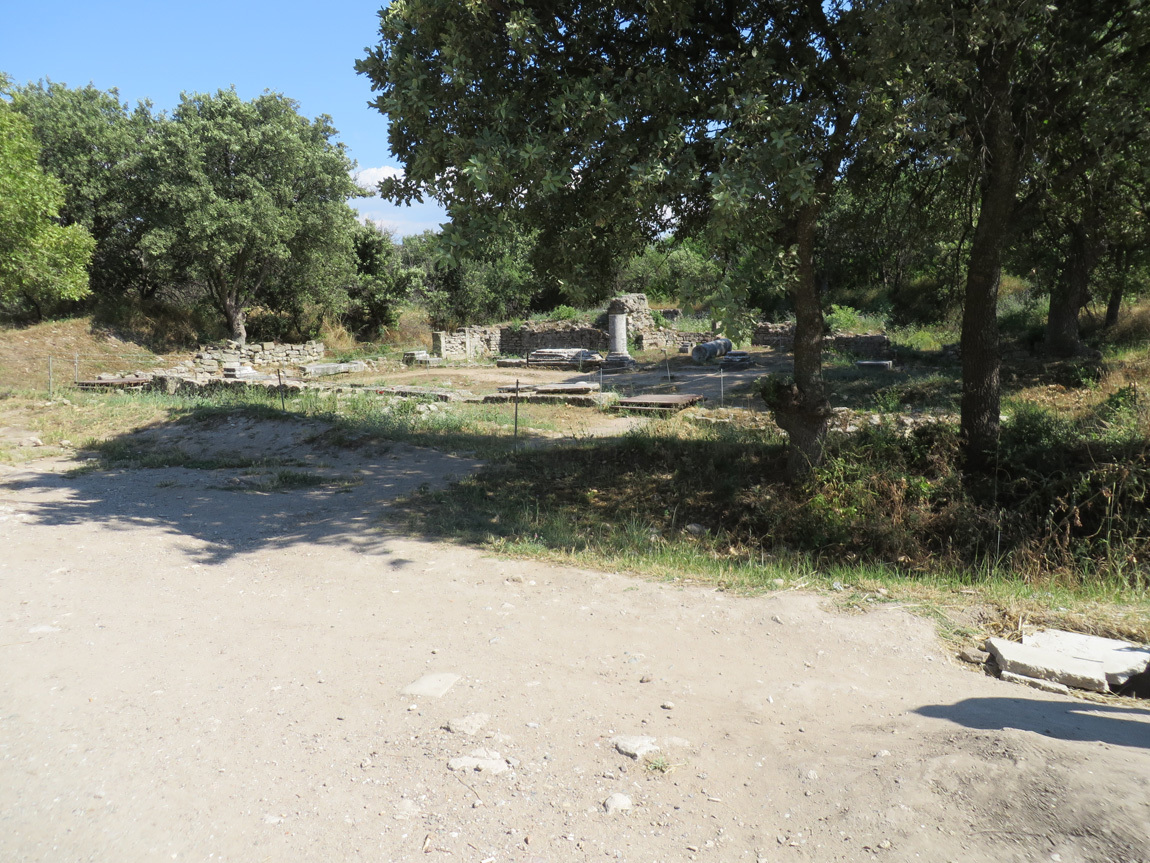
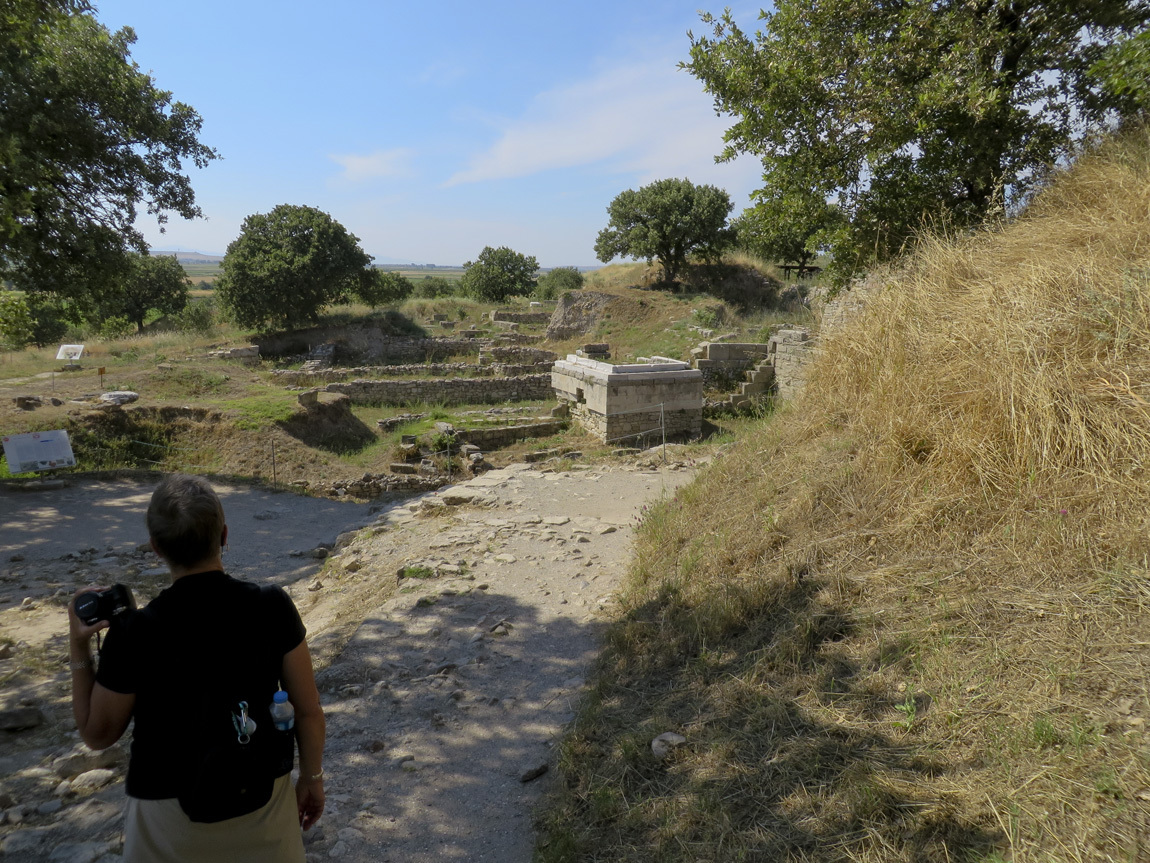
After only an hour, it's time to leave Troy. In the parking lot on the walk to the bus, I heard the familiar cooing of Eurasian Collared Doves. Only recently this species of bird has made it's way to Colorado.
Our next destination is a boutique hotel in Assos, a couple hours away. Another post.
Navigation:
first Turkey post
next blog entry
We have all heard of Troy, but before our trip to Turkey, I wasn't sure whether Troy was a mythological or a historical location. In school, we all learned about Homer, who wrote of the Trojan Wars in his famous epic narrations, the Illiad and the Odyssey. True stories, or not? I didn't know, but I had never heard of anyone visiting Troy. And if asked, I would have guessed that Troy was in Greece.
But our trip to Turkey set me straight. Troy was an actual city. More specifically, the location of Homer's Troy was the location of many cities, each built on the ruins of the last. The location is in Anatolia, in Turkey, on the northwestern coast. It's off the beaten path - it's not near a modern city, although it is near a major highway.
According to legend, the Trojan Wars began after Paris of Troy took Helen ("Helen of Troy") from her husband Menelaus, the king of Sparta (an ancient Greek city state). This sparked a conflict between the Trojans and the Greeks (also called the Achaeans - "from across the Aegean Sea"). At one point, the Greeks offered a wooden horse as a gift to the Trojans, and as we all know, it was filled with soldiers who took over Troy. Thus: the Trojan Horse.
The ancient Greeks, at least, believed that the Trojan War was a real event that took place in the 12th century BC (1300-1190 BC). The site of Troy, the Greeks believed, was on the Anatolian peninsula, on the Dardanelles, that strategic spot to control waterways.
Up until the late nineteenth century, the Trojan Wars and the city of Troy were thought by most of the world to be just Greek mythology, not historic fact. Then, in 1864 an English archeologist named Frank Calvert began excavations on a farm owned by his family on Hisarlik Hill, near the Dardanelles. He believed that this was the site of ancient Troy. In 1868, Calvert convinced Heinrich Schliemann, a German businessman and archaeologist, to join the excavation.
What the archaeologists found were ruins of ancient cities. Eventually the finds convinced the world's historians that the site is indeed that of the ancient city of Troy. Not only that, ruins of at least eight other cities are found in sequential layers on the site. The different city layers are numbered in roman numerals from I to IX, with I being the oldest. The first city, Troy I, was Wilusa, existing about 3000 BC. Troy I was founded by the Hittites, the first Anatolian people to form a city state. Troy VII is probably Homeric Troy. The last city is Hellenistic Illium, around the 1st century BC.
Here is a list of the different Troys that I nabbed from Wikipedia:
Troy I 3000-2600 BC (Wilusa)
Troy II 2600-2250 BC
Troy III 2250-2100 BC
Troy IV 2100-1950 BC
Troy V: 20th-18th centuries BC
Troy VI: 17th-15th centuries BC
Troy VIh: late Bronze Age, 14th century BC
Troy VIIa: 1300-1190 BC, most likely setting for Homer's story
Troy VIIb1: 12th century BC
Troy VIIb2: 11th century BC
Troy VIIb3: until c. 950 BC
Troy VIII: around 700 BC
Troy IX: Hellenistic Ilium, 1st century BC (existed until Constantinople established, gone before Ottomans)
The photo below shows the entrance to the historical site of Troy.

Near the entrance are piles of different relics, like this pot:

Here are some columns and parts of walls:

These pipes carried water in the ancient cities:

The path takes us towards ruins and a small hill. It's mindboggling to think that all that we are about to see was covered with earth until the late 1800s when the excavations began.

This sign signifies that the ruins of Troia (Troy) date from Ilios (1st century BC, Troy IX) to Wilusa (3000 BC, Troy I).

As we near the ruins, we see the remains of a structure. See that red umbrella in the right of the photo? That's where Ali is waiting for us. Our whisperers are on, and he will talk about the structures that we see.

In the photo below, we have arrived at the spot where Ali is in the last photo. We see a narrow, curving passageway. In Homer's Troy, the narrow passageway made it easy to screen for foes and protect the city. As I walk through the narrow corridor, I think what it must have been like 3000 years ago. Were there armed guards on the walls? What sort of wonders are the wall guarding? What would I be wearing? Was it as hot then as it is now? (It's so dang hot that I wonder why anyone ever built a city here!)

The inset in the wall is a stone culvert for water. There was once an artesian well system, constructed first in Troy VI and restored in Troy VII.

Further on, we see parts of walls from different times. We are now climbing up the small hill.

From the top of the hill, we can see out into a fertile Aegean plain, with a river running through it. Today, this Troy site is a few miles inland from the Aegean Sea, but at the time of Homeric Troy, the site was on the mouth of a river that formed a natural harbor on the Aegean, near the Dardanelles. Over the years, the mouth of the river filled in with silt, clay, sand and gravel, and is now a plain.

A sign says: "You are now standing on what remains of the foundations of an altar which belonged to the Greek and Roman temple of Athena. The remains of this temple had already been removed by stonerobbers when Schliemann began his excavation in 1871. Other limestone foundations were discovered at the same level. These derive from statues, altars and other small architectural features in the courtyard of the temple precinct, and some of their marble fittings have been found."

A sign says: "Where you are now standing there once lay the forecourt of the temple of Athena belonging to the Greek and Roman city of Ilion (Troy I). Looking down you can see in the center of the mound a wide area at a lower level. This was excavated by Schliemann and Dorpfeld. The marble architectural fragments lying there originally belonged to the temple of Athena. The temple, whose base measured 36m x 16m, was surrounded by a Doric colonnade supporting a coffered ceiling. Outside, on the entablature, were metopes (reliefs) the most famous of which shows Apollo/Helios. This is now displayed in Berlin."
Berlin! They took the artifacts from the Ottomans and put them in a German museum. The Turks are still negotiating to get them back.
The sign continues: "It is thought that the temple was built by Lysimachus, one of Alexander the Great's successors, around 300 BC. In Greek and Roman times the temple was the focal point of a great annual festival in honor of the goddess Athena. This festival was marked by sacrifices and athletic contests."



The sign in this photo says "original foundation stones belonging to the fortification wall and towers of Troia II, III (c 2500 BC)".

This is the view of the outside of the Troia II/III Citadel Wall, ca 2500-2200 BCE (Schliemann's "Burnt City"). This is a reconstruction built with hand-made and fired mudbrick. The reconstruction conceals and protects the original mudbrick material. A fire gave the original brick of the upper and outer part of the wall a red color.

Inside the Citadel is a mudbrick building with a stone foundation excavated in 1998/99. This building was found with its walls still standing up to a height of over 1.5 meter. In 2003, a roof was built over the mudbrick building so that it could be opened to the public without the archaeological material being harmed.



The photo below shows part of the fortifications of Troia I. Troia I was built c 2920 BCE directly on bedrock. Archaeological deposits four meters deep suggest a long period of occupation. The slightly inward-sloping fortification wall enclosed a settlement with a diameter of about ninety meters. In front of the tower stood at least one stone slab or stele with relief decoration showing the upper half of a human figure possibly holding a weapon.

Schliemann made a deep trench, forty meters wide and seventeen meters deep, through the center of a mound. Schliemann was looking for the treasure of "Priamâ€s Citadel". He destroyed remains of buildings from the overlying layers while digging this trench. At the bottom of the trench Schliemann found remains of walls belonging to the early Troia I period (c 2920 BCE). You can see these in front in the photo below. It was only in the American excavations of the 1930s and in the work carried out since 1988 that the Troia I period was more closely studied. The rows of parallel, rough stone walls are the foundations of relatively large, close-set houses.

Schliemann was kind of a rat. During the excavation of Troy, he came across a remarkable copper article behind which he saw gold artifacts. He called a lunch break so the workers would leave the area. He proceeded to secretly take the treasure and smuggle it out of Anatolia. This treasure is known as "Priam's Treasure', because Schliemann believed it was from a king during Troy VI or VII. Most likely though, it was from Troy II because of the level at which it was found. He was found out when his wife wore some of the jewels in public in Germany. Today, some of this treasure is in Berlin, some in Moscow, and some in Istanbul.

The photos below are of the south gate of Troia VI, probably the principal entrance to the citadel. Only the roadway to the gate survives today. It led in a straight line up into the citadel and was entirely paved with stone slabs. In the middle of the road was a drainage channel that ran beneath the paving stones. You can also see remnants of the South Tower of Troia VI. The walls are built directly on bedrock and two meters of them are preserved. Stone stelae (decorated slabs) stood in front of the tower. There are also remnants of a house called the Pillar House. (Note: Troy VI was before Troy VII, around 1700-1250 BCE.)


Below are photos of a Roman Odeion (similar to an ampitheater), intended for the presentation of musical performances. The Odeion has a semi-circular orchestra, with a skene (stage-building) in which stood an over-lifesize statue of the Emperor Hadrian (117-138 AD). The orchestra is bordered by a wall of limestone slabs above which rise tiers of seats constructed of large limestone blocks. Visible behind the Odeion are the Troia VI walls and Pillar House.



Next to the Odeion were bath houses and an agora (market place), where the public life of the city was focused.


After only an hour, it's time to leave Troy. In the parking lot on the walk to the bus, I heard the familiar cooing of Eurasian Collared Doves. Only recently this species of bird has made it's way to Colorado.
Our next destination is a boutique hotel in Assos, a couple hours away. Another post.
Navigation:
first Turkey post
next blog entry
Comments
No comments yet
Add Comment